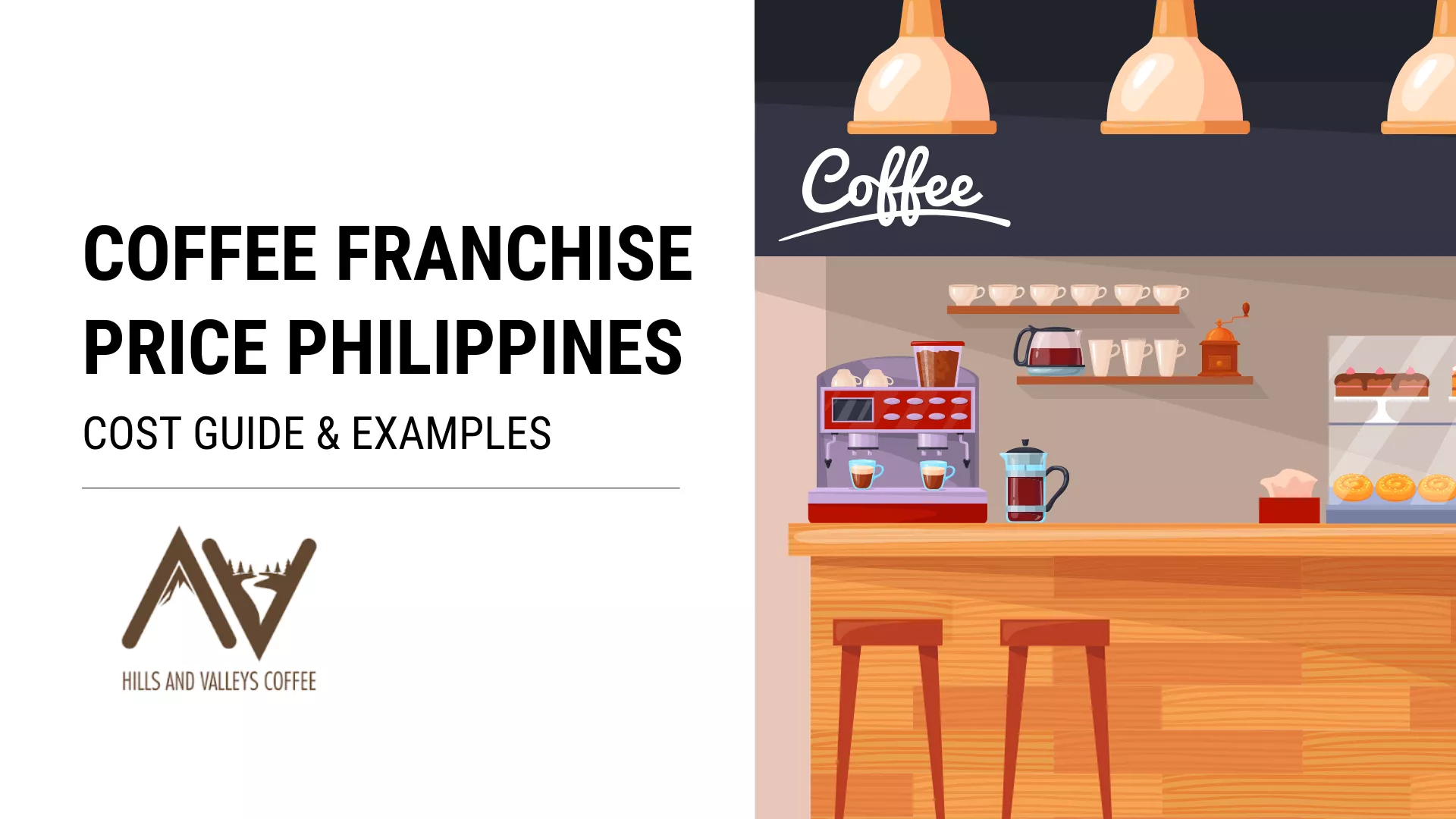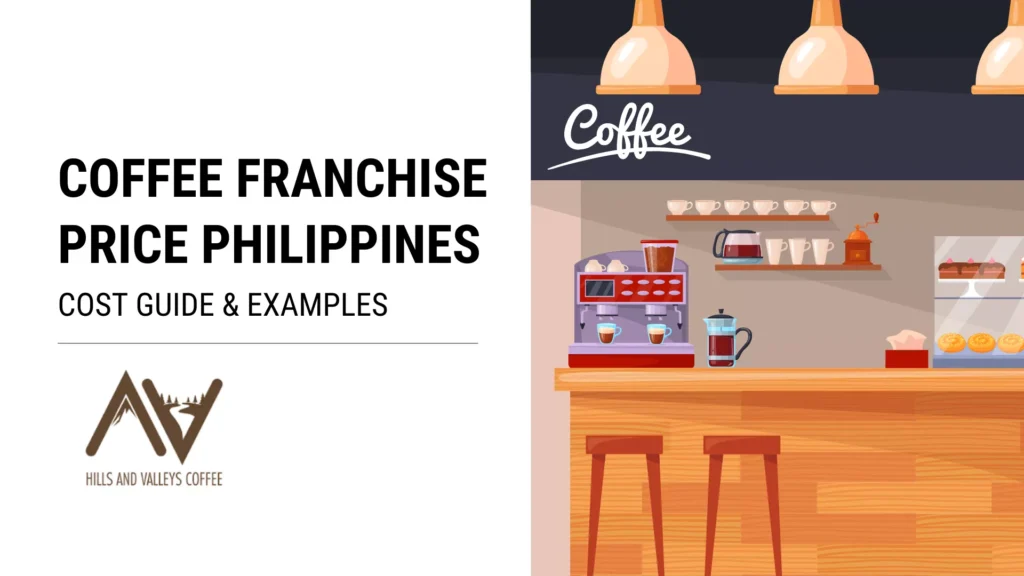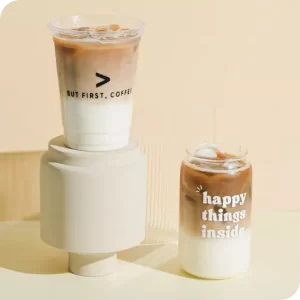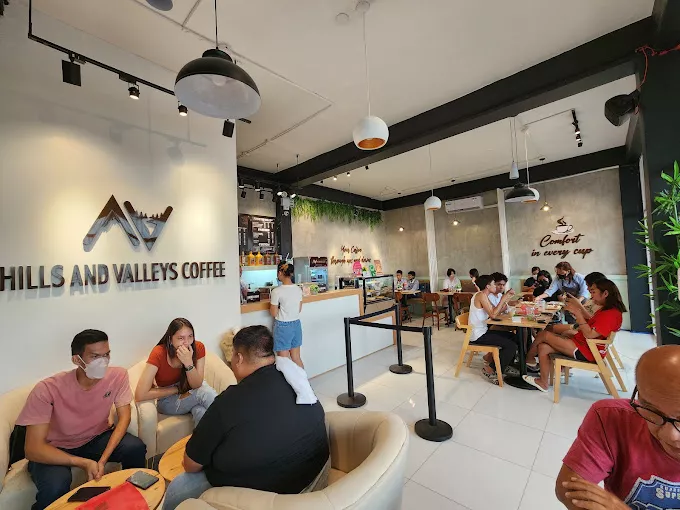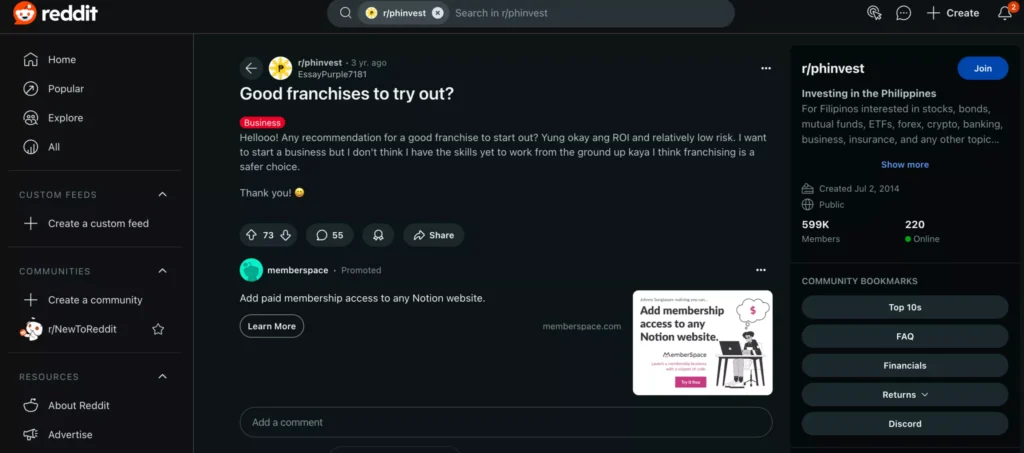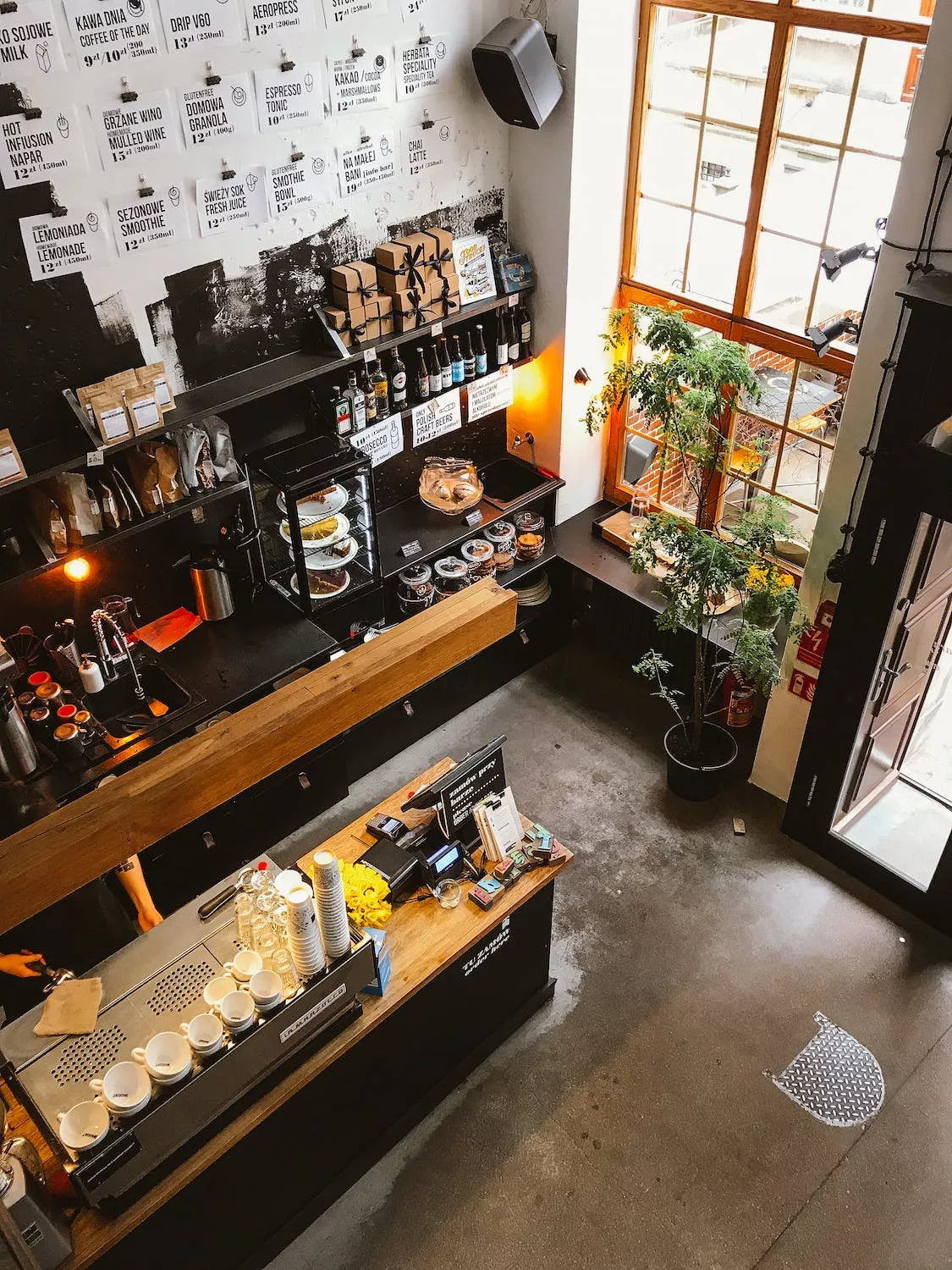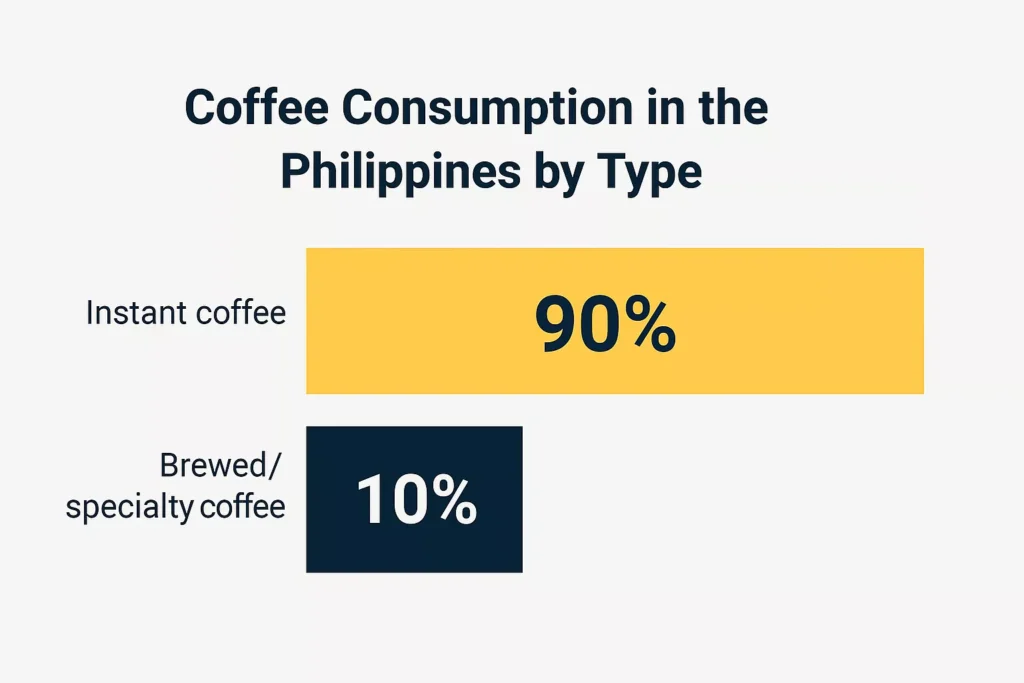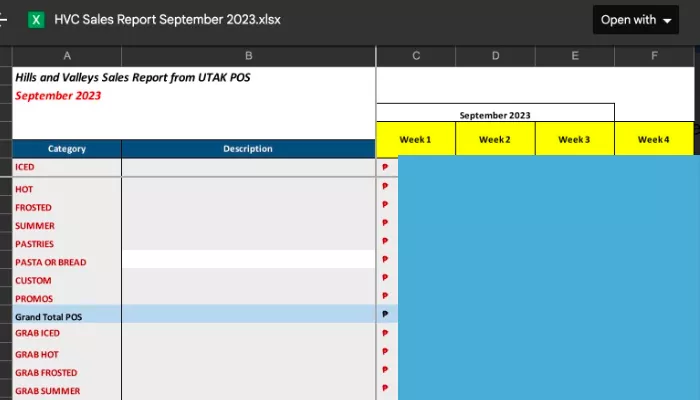Coffee Franchise Cost in the Philippines [2025 Breakdown & Examples]
How Much is a Coffee Shop Franchise in the Philippines?
The coffee franchise price range in the Philippines starts at ₱100,000 and goes up to ₱1.5 million and above.
Coffee Franchise Price Range in the Philippines
Here's a breakdown of three standard pricing tiers for coffee franchises.
Low-Tier Coffee Franchises (₱100,000 to ₱500,000)
Low-tier coffee franchises are budget-friendly and usually serve as an entry point for new entrepreneurs looking for affordable cafe packages. The primary focus of their operations is to achieve high-volume sales with low overhead costs, thereby generating more monthly profits.
Key Features:
- Business format: Small coffee kiosks, food carts, or mobile setups
- Menu: Basic hot and iced coffee, minimal customization
- Location: Markets, terminals, school areas, and community spaces
- Support: May include basic training and branding, but setup is often handled by the franchisee
- Inclusions: Coffee equipment, starter inventory, and signage
Ideal For: First-time business owners or those testing the coffee market with low risk and quick setup.
Mid-Tier Coffee Franchises (₱500,000 to ₱1.5 million)
Mid-tier coffee franchises are the most popular option for entrepreneurs who want a balance between cost and value, not too pricey, yet suitable enough to have robust support, modern branding, and a more comprehensive business system.
Key Features:
- Business format: Coffee kiosks or compact café-style shops
- Menu: Wide drink selection, including blended coffee, cold brews, and specialty drinks
- Location: Inside malls, commercial buildings, or neighborhood hubs
- Support: Franchisee training, operational manuals, soft opening assistance, and supplier access
- Inclusions: Full coffee setup, signage, small construction, uniforms, and marketing materials
Ideal For: Entrepreneurs looking to operate a branded coffee business with professional systems in place, while keeping the investment below ₱2 million.
Premium Coffee Franchises (₱1.5 million and above)
Premium coffee franchises are for investors with more capital and those who want a full-service café experience. You can expect a well-known brand to offer this type of franchise package, providing complete turnkey solutions.
Key Features:
- Business format: Full dine-in coffee shops with custom design and layout
- Menu: Complete food and beverage offerings, from espresso-based drinks to sandwiches and desserts
- Location: High-traffic malls, lifestyle centers, central business districts
- Support: End-to-end setup, from site selection and construction to staff training and national marketing
- Inclusions: Premium coffee machines, high-end furniture, full kitchen, branded interiors, digital menu boards
Ideal For: Business owners or investors who aim to build a large-scale operation with strong brand backing and a complete café experience.
💡 Planning to start your own coffee business? Learn the exact steps, legal requirements, and startup tips in our guide on how to start a franchise business in the Philippines.
What Is Included in the Coffee Franchise Price?
Starting a coffee franchise in the Philippines involves more than just buying the brand name. The total franchise cost usually includes several key elements. Understanding each of these cost factors can help you assess the actual value of your franchise investment.
Franchise Fee
If you're not familiar, the franchise fee is the initial payment you pay (required) to join a coffee franchise. It gives you the legal right to operate under the brand's name, use its business model, and access its operational systems, including coffee preparation protocols, POS system usage, staff scheduling, and training and onboarding systems.
In other words, your franchise fee is your official entry point into the franchise system.
While franchise fees vary depending on the coffee franchisor you're engaging, the fee typically includes:
- Trademark rights - use of the company's name, logo, and branding.
- Business model access - proven systems for running operations, serving coffee, and managing staff.
- Manuals and guides - SOPs that cover every part of the business.
Most coffee franchisors will require you to pay franchise fees upfront, and these fees are generally non-refundable. It is also a one-time cost within a specified timeline (2 years, 3 years, or 5 years), with renewable fees of half the total franchise fee if you choose to renew after the franchise term.
In the Philippines, coffee franchise fees will depend on the brand's popularity and existing capabilities:
- ₱100,000–₱400,000 for smaller or emerging local brands
- ₱450,000–₱800,000 for mid-sized (established) local brands
- ₱800,000–₱1 million+ for well-known national or global chains
You'll find lower franchise fees for smaller or emerging local coffee brands, as they typically have fewer inclusions and less brand recognition. Conversely, higher costs are expected from well-known, established brands with a strong market presence, such as Bo's Coffee.
My recommendation is always to check what the franchise fee covers before signing a formal agreement with the franchisor. Ask as many relevant questions as you can to help you assess whether the franchise fee is worth your investment.
Equipment and Setup Costs
You can't run a cafe without its major equipment, such as espresso machines.
Generally, coffee franchisors will provide you with the basic equipment you need to operate your coffee shop as part of your franchise fee. Others would charge additional fees if you want to upgrade to better equipment. This is primarily the case if the franchisor sees that your location has high traffic, which means you need a solid espresso machine, such as a 2-group espresso machine, to cater to a long line of customers.
What equipment is typically included in franchise fees?
- Espresso machines (single or double group heads)
- Coffee grinders
- Milk frothers and blenders
- Knock boxes and tamping tools
- Basic POS system
- Cash register
- Receipt printer
For coffee franchises that offer drip coffees (and other types of coffee), they usually provide drip brewers or French presses.
What is typically not included in franchise fees?
- Refrigerators for milk and perishables
- Freezers for ice and frozen items
- Storage racks and dry goods shelving
- Digital POS terminal
- Construction and store setup
- Utilities and installations
Inventory and Supplies
Before your store's grand opening, you need to have an inventory of supplies, which includes ingredients, packaging, and cleaning materials.
Most coffee franchisors in the Philippines, like those offering our coffee franchise packages, provide a starter inventory kit designed to last for about a month of operation.
What's typically included in the initial inventory:
- Coffee beans or ground coffee (house blend or signature roast)
- Milk, cream, and milk alternatives
- Flavor syrups (e.g., caramel, hazelnut, vanilla)
- Sugar, sweeteners, and powdered drink mixes
- Non-coffee ingredients (such as teas and pastries).
- Packaging and serving materials (hot and cold branded cups, lids, straws, stirrers, napkins, cup sleeves, takeout bags, and boxes)
- Uniforms and other store items (branded aprons, shirts, name tags, hairnets, etc.).
As mentioned earlier, the starter kit covers a 30-day period. After the first month, you will need to reorder supplies on a regular basis.
As a general rule, franchisors typically require you to order from their central hub (warehouse) or from accredited suppliers to ensure consistency in quality and taste.
One upside of Philippine coffee franchising is that most franchisors provide tracking tools or reorder schedules to help maintain stable operations and avoid running out of stock.
Training and Support
One of the primary reasons aspiring entrepreneurs enter coffee franchising is that there is an established training process. It's one of the more tedious options if you want to create your startup's brand - in the case of franchising, it's an obvious advantage.
Additionally, the franchisor provides services such as hiring, onboarding, and training your baristas to prepare products according to their coffee preparation guidelines.
Obviously, you need good training to expect consistency in quality and customer service for your franchise store, especially for franchisees who still have full-time jobs and rely on their baristas and store managers to run the business. The idea is that the cafe must run sustainably, given the strong staff training.
What's included in franchise training:
- Barista skills training (how to use espresso machines and other equipment, step-by-step drink preparation, milk steaming, pouring, and presentation)
- Customer service training (handling orders, managing wait times and complaints, and upselling techniques)
- Store operations (opening and closing procedures, use of POS systems, inventory management, and daily reporting)
- Staff management (hiring guidelines, scheduling shifts, maintaining cleanliness, and hygiene standards).
- Food safety and compliance
Most initial barista training programs last between 3 and 7 days, depending on the menu offerings and the complexity of the operation. For mid-sized to established local brands, training is often held at the brand's headquarters or a franchisee's store.
Those are mostly what you'll expect from franchisee training - before and during your store's grand opening. And for ongoing support after opening, coffee franchisors must provide continued assistance to ensure franchisees operate smoothly.
Regular store visits and performance audits help staff and baristas maintain the quality of both coffee and customer service. Local marketing campaigns tailored to the franchisee's location and target audience must also be regular to bring in new customers to the store.
Marketing Campaigns
The need to market the store is still expected, even for established brands, as marketing helps generate more customers and build brand awareness to consistently bring in new sales at both national and local levels.
Coffee franchisors in the Philippines often include marketing expenses either as a one-time fee in the franchise package or as a recurring monthly charge.
For local franchise stores, the marketing fund is used for grand opening events, flyers, posters, point-of-sale materials, and digital marketing campaigns aimed at targeting potential customers within the geographical area.
Given the brand's strong and established reputation and advertising power, potential coffee franchisees can expect to have brand recognition among customers, resulting in a consistent flow of traffic to their stores.
Looking for a Practical and Profitable Option?
If you're exploring coffee franchises that balance affordability with brand quality, Hills & Valleys offers a smart entry point. With packages starting at ₱490,000, we provide a complete kiosk setup, barista training, marketing support, and operational guidance - everything you need to get started strong.
Schedule your free franchise orientation today.
Best Coffee Shop Franchises Philippines in 2025
The Philippines has a thriving coffee culture, making a coffee shop franchise a promising business opportunity. Whether you're looking for a well-established brand or an emerging player with high-growth potential, choosing the right franchise can determine your success.
In this guide, we break down the best coffee shop franchises in the Philippines, covering franchise costs, brand strengths, and profitability factors to help you make an informed decision.
How We Chose the Best Coffee Franchises?
Selecting the best coffee shop franchises in the Philippines requires balancing investment costs, brand strength, and long-term profitability. You may prefer one main factor, but it is better to consider those three key factors to help you make the best decision for your coffee franchise.
To rank the top franchises, we created a list of 37 coffee shops that offer franchise opportunities and evaluated each brand based on the following key factors:
Franchise Investment – Initial Franchise Fee, Setup Costs, and Ongoing Fees
Franchising a coffee shop requires an upfront investment, but the value you get for your capital varies significantly. In our coffee franchise review, we considered:
- Initial Franchise Fee – The cost of securing the brand’s franchise rights
- Setup Costs – Equipment, store build-out, furniture, and branding materials
- Ongoing Fees – Royalties, marketing contributions, and operational expenses
Brand Recognition – Market Presence and Customer Loyalty
A coffee franchise’s success depends mainly on attracting and retaining loyal customers. We analyzed:
- Market Presence – How well-known the brand is and how fast it's expanding ("number of locations")
- Customer Loyalty – Whether customers actively seek out the brand
- Market Positioning – Is the brand catering to mass-market coffee drinkers or premium café customers?
For example, while long-established brands like Figaro Coffee are well-known, Hills & Valleys Coffee has quickly become a customer favorite due to its focus on premium-quality beans, handcrafted drinks, and modern café aesthetics. It has built a strong following among millennials and Gen Z customers who seek an experience beyond coffee.
Another factor we consider is the coffee shop franchise's popularity on different platforms and market opportunities. So, for instance, we removed less well-known brands that haven't had their own websites, are not part of Franchise Associations in the Philippines, or don't have a significant following on their social media profiles.
Franchisee Support – Training, Marketing, and Operational Assistance
A successful coffee franchise is more than just a brand—it should equip its franchisees with the tools to succeed. You would need to consider elements of franchisee support, such as:
- Barista Training – Ensuring consistent quality across all franchise locations
- Marketing & Branding Support – Digital advertising, social media promotions, and grand opening assistance
- Supply Chain & Inventory Management – Consistency in sourcing quality beans and ingredients
- Operational Support – Guidance on daily business management and troubleshooting
Profitability Potential – Projected Return on Investment (ROI)
Investing in a coffee shop should be financially rewarding, so we assessed each franchise’s profitability and ROI timeline based on:
- Breakeven Period – How long before a franchisee recovers their investment
- Profit Margins – Revenue potential vs. operational costs
- Sustainability – Long-term customer demand and brand growth
For example, while lower-cost franchises like Farron Café may have a faster breakeven period, their low price points result in lower profit margins per sale. In contrast, Hills & Valleys Coffee maintains a strong balance between premium pricing and high demand, allowing franchisees to generate higher earnings per customer transaction.
With an average ROI timeline of 1.5 to 3 years, Hills & Valleys offers a profitable and sustainable model for franchisees willing to invest in quality over volume. Hills & Valleys Coffee emphasizes brand experience and customer retention, leading to repeat customers and steady revenue growth, unlike mass-market brands that rely on high sales volume.
Another factor we consider is the price of beverages each coffee shop franchise offers. We remove in priority the lower-ranked franchises that sell absurdly cheap coffee (e.g., Php 25 to 50).
The reason is that you need to have a larger volume of sales to be profitable in that kind of coffee franchise. Though you may have a lower startup cost (as most offer it within Php80,000 to Php 250,000), you would find it difficult to get more returns from your investment in the long run.
Unique Selling Points – What Makes the Brand Stand Out?
With so many coffee franchises in the market, differentiation is key. We looked at what sets each brand apart, including:
- Signature Offerings – Specialty drinks, premium beans, or unique blends
- Additional Flavors to the Menu – is the franchisor shelling out new flavors each month?
- Store Concept & Ambiance – Is it an aesthetic café, a minimalist grab-and-go stall, or a hybrid?
- Menu Innovations – Does the brand introduce seasonal drinks, specialty teas, or locally inspired flavors?
All the above points factor into play when we review the best coffee franchises in the Philippines.
And for the final verdict.
Which Coffee Franchise is Best for You?
Here's a quick summary to help you decide:
☕ Best for premium specialty coffee → Hills & Valleys Coffee
☕ Best for full-service café model → Figaro Coffee
☕ Best for budget-friendly, minimalist branding → But First Coffee
☕ Best for strong, high-caffeine coffee niche → Palpitate Coffee
☕ Best for low-cost startup → Farron Café
Before investing, reach out to each franchisee to discuss requirements, profitability projections, and available store locations.
Best Coffee Shop Franchises in the Philippines in 2025
1. Hills & Valleys Coffee Franchise
The Hills & Valleys Coffee Franchise offers a unique opportunity to turn your love for coffee into a thriving business. Every cup represents passion, dedication, and a commitment to excellence. As a franchisee, you become part of this story, bringing an exceptional coffee experience to your local community.
Choose from three flexible franchise packages: Deluxe Cart, Fit Out, and Store. Each option caters to different investment levels and business goals, making it easier for aspiring entrepreneurs to start their journey.

Hills & Valleys Coffee Franchise: Exciting Packages to Kickstart Your Coffee Business
Deluxe Cart Package
Investment: P495,000
Inclusions:
- 5 Years Franchise Fee
- Full Construction Cost
- Franchisee Training
- Operations Manual
- Use of Business name and Logo
- 1 Month Worth of Coffee Supplies
- Espresso Machine
- Grinder
- JTC Blender
- Social Media Advertising (worth P3,000)
- Food delivery app application assistance
- POS (1st 6 months Subscription)
For Inquiries:
Mobile/Viber: 0906 232 0168
Email: hillsandvalleyscoffee@gmail.com
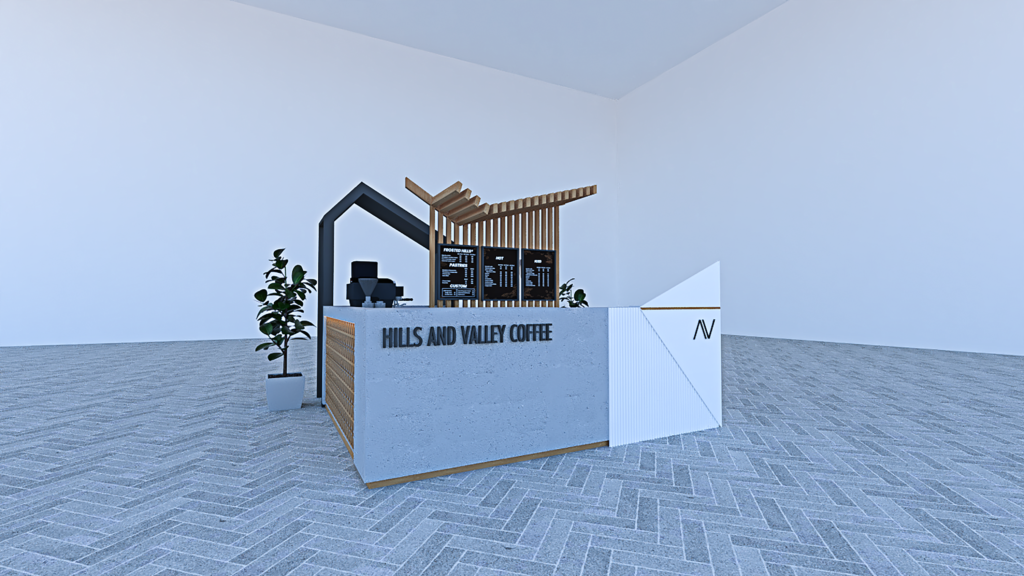
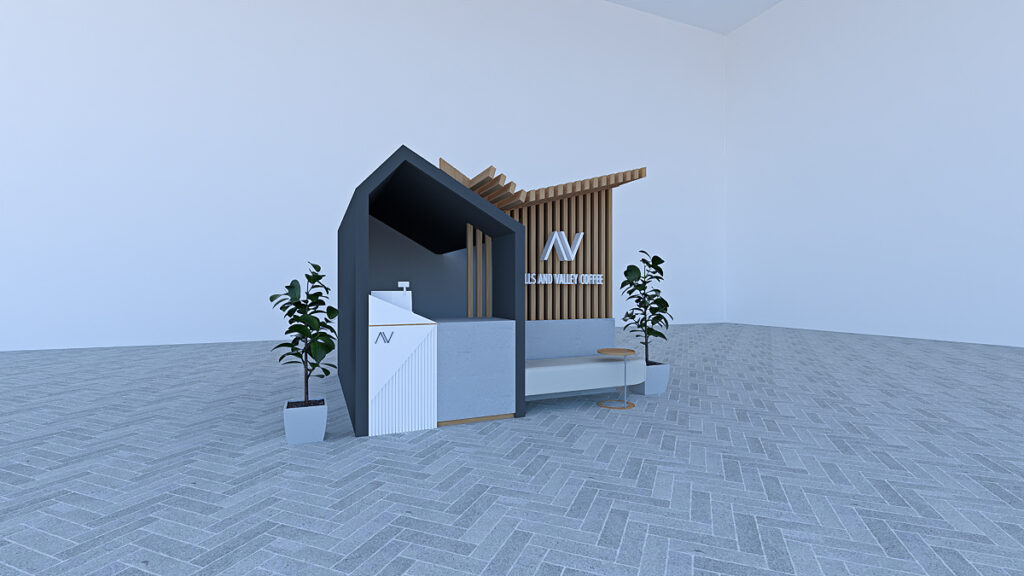
The Deluxe Cart package is the ideal choice for entrepreneurs looking for a versatile and portable coffee business. Designed for high-traffic locations like malls and supermarkets, this fully furnished coffee cart allows you to bring premium coffee to busy customers with ease.
With the iconic Hills & Valleys Coffee logo displayed prominently, your cart will attract attention and create a welcoming coffee experience wherever you set up. Enjoy the freedom and flexibility to serve great coffee in dynamic locations while maintaining a professional and inviting ambiance.
Cafe Fit Out Package
Investment: P495,000 + Construction Cost
Inclusions:
- 5 Years Franchise Fee
- Franchisee Training
- Operations Manual
- Use of Business name and Logo
- Social Media Advertising (worth P10,000)
- Food delivery app application assistance
- POS (1st 6 months Subscription)
- Espresso Machine
- Grinder
- JTC Blender
- Supplies and Accessories
- 1 Month Worth of Coffee Supplies
For Inquiries:
Mobile/Viber: 0906 232 0168
Email: hillsandvalleyscoffee@gmail.com
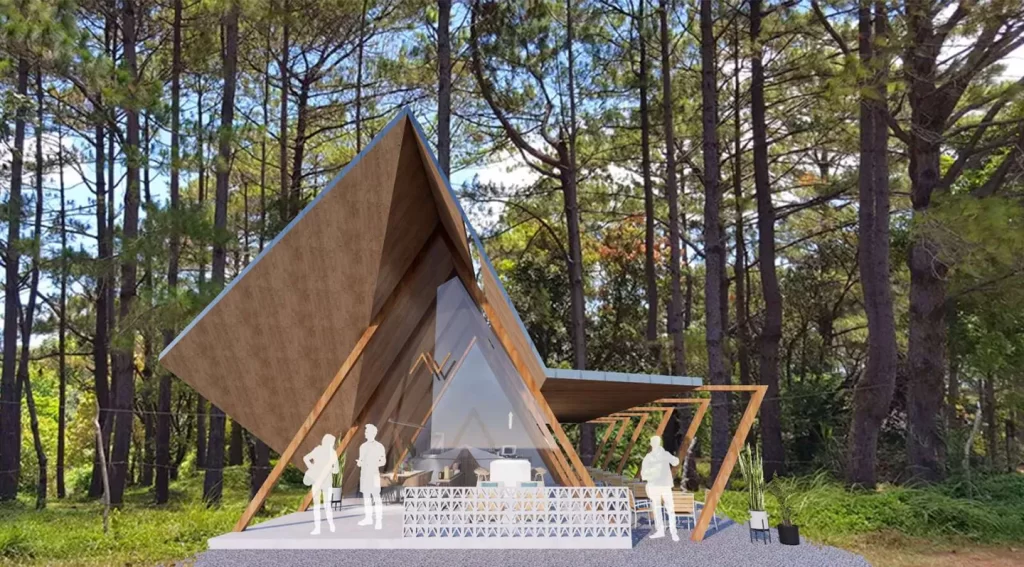
The Fit Out franchise package is ideal for those who want a compact coffee shop in outdoor locations like parks and tourist spots. This turnkey solution transforms a suitable space into a Hills & Valleys Coffee outlet.
Our team works closely with you from design to setup, ensuring a smooth process. Together, we’ll create an inviting space that reflects the brand’s style while maximizing efficiency and functionality. Bring your coffee shop vision to life with the Fit Out franchise package.
Store Package
Investment: P495,000 + Construction Cost
Inclusions:
- 5 Years Franchise Fee
- Franchisee Training
- Operations Manual
- Use of Business name and Logo
- Social Media Advertising (worth P10,000)
- Food delivery app application assistance
- POS (1st 6 months Subscription)
- Espresso Machine
- Grinder
- JTC Blender
- 1 Month Worth of Coffee Supplies
For Inquiries:
Mobile/Viber: 0906 232 0168
Email: hillsandvalleyscoffee@gmail.com
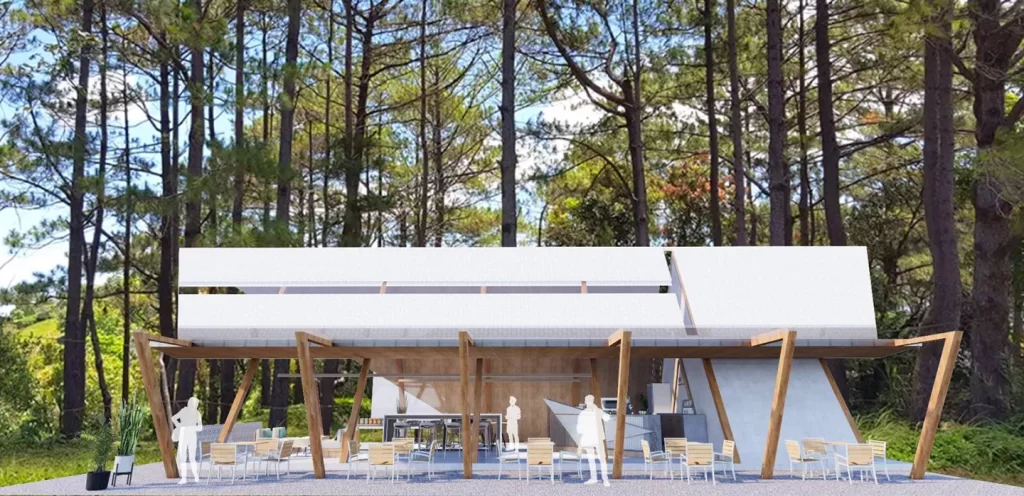
The Store package is a great opportunity for entrepreneurs to build a thriving coffee shop in prime indoor locations like malls, supermarkets, business centers, and commercial buildings.
This package provides a spacious setup with a comfortable seating area, a dedicated coffee bar, and a selection of pastries and sandwiches to complement the coffee experience.
We offer full support, from site selection and interior design to sourcing high-quality equipment and staff training. The Store package is perfect for those who want to create a bustling coffee destination where customers can enjoy premium blends in a cozy and welcoming atmosphere.
For more information and inquiries, please contact us through the following channels:
Mobile/Viber: 0906 232 0168
Email: hillsandvalleyscoffee@gmail.com
2. Figaro Coffee
Figaro Coffee is a well-known brand in the Philippines, offering a variety of high-quality coffee, pastries, pasta, panini sandwiches, and salads. The brand provides multiple franchise models, allowing entrepreneurs to serve premium coffee in different settings.
Franchise Models
- Full Store (60-80 sqm) – Serves the full menu. Contract term: 8 years (renewable every 4 years).
- Kiosk Store (30-40 sqm) – Offers a full line of beverages, pastries, and light meals. Contract term: 5 years (renewable every 5 years).
- Cart/Kiosk (10-20 sqm) – Focuses on beverages and pastries. Contract term: 5 years (renewable every 5 years).
Franchise Inclusions
The total investment covers the franchise fee, site assessment, store design, construction, equipment, initial stocks, uniforms, and marketing materials.
For inquiries:
📞 (632) 706-0564 | (632) 671-4232 loc 19 | 63932-8468228
📧 franchise@figarocoffee.com
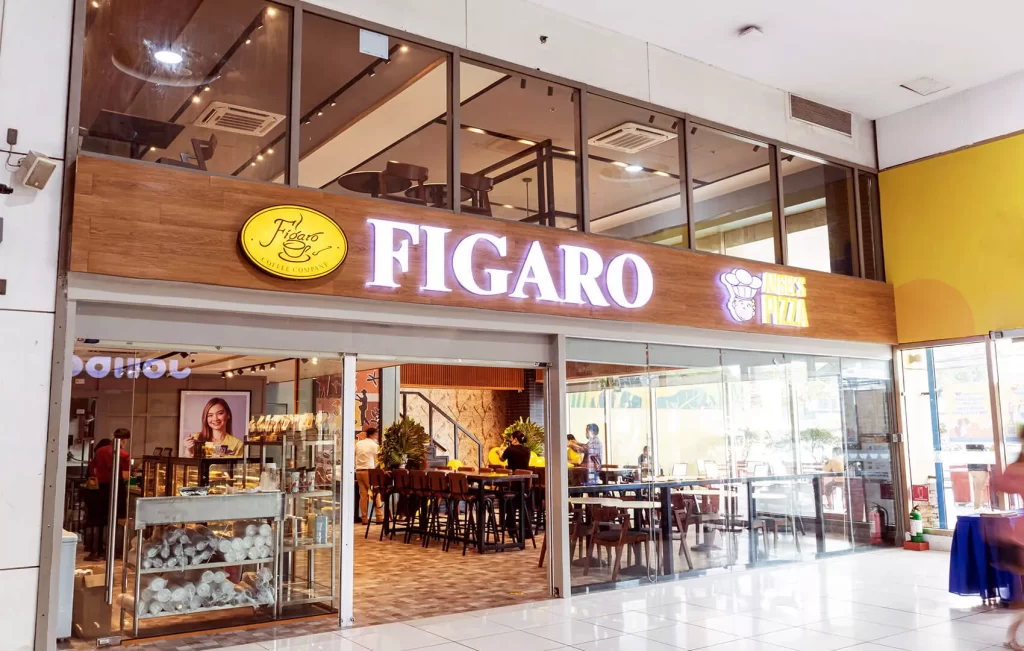
Image Source: Figaro Website
3. Farron Cafe
Farron Cafe started as a small business and has grown into one of the fastest-expanding coffee franchises in the Philippines, with over 600 outlets nationwide. The brand offers affordable gourmet coffee and competitive pricing compared to top brands.
Franchise Options
- Cart – ₱168,000 to ₱699,000
- Kiosk – ₱224,000 to ₱879,000
- Full Cafe – ₱280,000 to ₱1,200,000
Franchise Inclusions
Franchisees receive mentoring, supplies, equipment, licensing, marketing assistance, and training in coffee preparation and business operations.
How to Franchise
- Submit an application form with business details.
- Attend a meeting with the franchising team.
- Pay the franchise fee and sign the agreement.
- Get location approval and settle the remaining balance.
- Complete barista training and prepare for opening.
For inquiries:
📞 0922 803 3322 / 8 294 0295
📧 franchisefarrongroup@gmail.com
4. But First Coffee
But First Coffee has expanded rapidly, growing to 90 branches nationwide in just two years. The brand became popular during the pandemic by offering affordable, high-quality coffee while supporting local farmers.
Franchise Packages
- Indoor Cart – ₱1,000,000
- Outdoor Cart – ₱1,500,000
- Customized Store – Pricing based on design and space requirements
Franchise Inclusions
Franchisees receive training, business name rights, marketing support, a POS system, supplies, equipment, and orientation on business permits.
BFC continues to expand, focusing on business districts, residential areas, and commercial hubs across Metro Manila and other key cities.
5. Palpitate Coffee
Located inside an indoor go-kart track in Taytay, Rizal, Palpitate Coffee offers a unique experience where customers can enjoy premium coffee alongside high-speed kart racing.
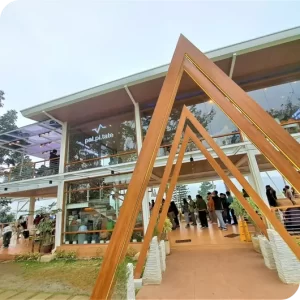
The shop features a minimalist ambiance, serving an extensive range of coffee options. Their signature Palpitate Blend is known for its rich cedar notes and balanced sweetness.
For franchise details and applications: 📧 palpitatecoffee.ph@gmail.com
Key Factors to Consider Before Franchising a Coffee Shop
Franchising a coffee shop requires careful evaluation and decision to ensure you're giving yourself a chance to succeed in this line of business.
While an established coffee shop brand provides built-in recognition, factors like location, costs, and operational requirements can significantly impact your return on investment.
Based on global standards in choosing the right coffee shop franchise, here are our top-of-the-list considerations before franchising a coffee shop.
Location and Market Demand
Fifty percent of success when starting a coffee shop lies in its location. Knowing the location spots where there is high foot traffic could help you increase the odds of new daily customers to your store.
High-traffic areas such as malls, business districts, and transport hubs can help attract consistent customers, while standalone locations may require aggressive marketing for both ends of franchisor and franchisee.
So, before choosing a location, analyze customer behavior, competitor density within the area (which means knowing who your competitors are), and purchasing power within the target location.
If you're targeting office workers, focus on convenience and speed. If catering to a leisure crowd, prioritize ambiance and seating.
Generally, franchise agreements may restrict store placement, so it is best to consult your preferred franchisor (or ask questions during your franchise orientation).
Franchise Costs and Fees
Franchise investments vary widely, from small kiosks to full-scale cafés, requiring capital ranging from Php 300,000 to over Php 10 million.
Costs typically include the franchise fee, store setup, equipment, and initial inventory. On top of that, you'll have to look at ongoing expenses such as royalties, marketing fees, and operational costs that must be factored into profitability calculations.
Some franchises require revenue-sharing agreements (as with co-franchise contracts), which can impact net income.
Always request a breakdown of costs and projected earnings before signing a contract to assess financial viability.
Brand Strength and Competitive Advantage
A well-known franchise benefits from an established brand presence, but market saturation (like what is currently happening in the Philippines) can impact growth potential.
Research how the brand differentiates itself through premium coffee, unique menu offerings, or strong marketing support. Factor in all these, as they significantly impact you as a franchisee.
The competition may limit profitability if multiple franchise locations already exist in your target area. The best thing about some coffee shop franchises, like the case of Hills and Valleys Cafe, is that they only allow one franchise location within a radius of 5 km. This allows the franchisee to dominate the area without competing with other franchises of the same brand.
Also, compare how each franchisee supports franchisees in advertising, menu innovation, and customer engagement. A brand with strong local (or international recognition) has leverage and more significant advantages in stabilizing the franchise location, even if it's new in the area.
Training and Franchisee Support
Franchisors offer varying levels of training and operational assistance, which can help determine your store's efficiency (primarily with your barista staff).
Generally and must be part of any franchise requirement, coffee shop franchises offer barista training, inventory management guidance, and direct marketing strategies.
Some offer ongoing support, a key factor in the franchising model, while others provide only initial training. So, evaluate the franchise's involvement in daily operations and whether it assists with troubleshooting issues.
Strong franchise support reduces operational risks and ensures consistent quality across all locations.
Operational Requirements and Staffing
Running a coffee shop requires hiring and training baristas, managing inventory, and maintaining consistent service quality. Some franchises have strict operational guidelines, including their supply chain system, which only requires specific suppliers and service procedures.
Labor costs, shift scheduling, and employee retention are critical factors in operational excellence. If the business model relies on high-volume sales, efficient workflow and quick service times are essential to achieve that.
Evaluate whether the franchise model aligns with your franchisor's management style and ability to oversee daily operations.
Long-Term Profitability and ROI
A franchise with a high initial investment must generate strong sales to ensure a reasonable return on investment. A good timeline must be half the franchise agreement. So, if the franchise contract lasts only 5 years, the franchisee must get his investment back within 2.5 to 3 years.
Check franchise case studies and profitability timelines. Some coffee shop franchises break even within 2 to 3 years, while others take longer due to high overhead costs.
When estimating long-term earnings, consider market trends, potential menu expansions, and seasonal demand fluctuations.
FAQs
How much does it cost to start a coffee shop franchise in the Philippines?
Franchise investments typically range from ₱300,000 for small kiosks to ₱5 million or more for full-scale cafés. Hills & Valleys Coffee franchise investment starts at approximately ₱1.5 million to ₱3.5 million, covering franchise fees, store setup, equipment, and initial supplies. This investment ensures a high-quality café setup with premium branding and specialty coffee offerings, making it a stronger long-term business compared to lower-cost kiosk franchises.
Which coffee shop franchise is most profitable?
Higher profit margins come from premium pricing, strong brand appeal, and high customer retention. Hills & Valleys Coffee offers a profitability range of ₱40,000 to ₱100,000 per month, depending on location and store size. Unlike budget-friendly coffee brands that rely on low-cost drinks and high sales volume, Hills & Valleys focuses on premium specialty coffee, where customers willingly pay more for quality and experience, leading to higher profits per transaction.
Is a coffee shop a good business in the Philippines?
Yes, the Philippine coffee industry is growing, with the specialty coffee segment seeing strong demand. Hills & Valleys Coffee is positioned in the high-growth market of premium handcrafted coffee, appealing to millennials, professionals, and social media-savvy consumers. With an increasing number of Filipinos willing to spend ₱150 to ₱250 per cup for high-quality coffee, a well-located Hills & Valleys Coffee franchise can generate consistent foot traffic and strong revenue streams.
How long does it take to get a return on investment (ROI)?
ROI in coffee shop franchises typically ranges from 1.5 to 3.5 years, depending on store format and location. Hills & Valleys Coffee franchisees can expect an ROI within 2 to 3 years, with high-traffic locations reaching profitability faster. With a focus on premium pricing, strong brand loyalty, and social media-driven customer engagement, Hills & Valleys Coffee provides a sustainable path to long-term profitability.
SWOT Analysis of Coffee Shop in the Philippines
Before launching your coffee shop franchise or starting your own cafe in the Philippines, you need to conduct a SWOT analysis to prepare for rational, objective decisions and create and execute strategies for growing your coffee shop.
What is SWOT Analysis For Coffee Shops?
SWOT analysis for coffee shops is a strategic planning tool used by coffee shop owners to evaluate their businesses in four key areas: Strengths, Weaknesses, Opportunities, and Threats.
Why Conduct a SWOT Analysis of a Coffee Shop?
Here are compelling reasons for conducting a SWOT analysis for coffee shops.
Identify Competitive Advantages
Knowing what distinguishes your cafe from your competitors can help you dominate your local market.
Strengths such as prime location, skilled workforce ('baristas'), or affordable coffee help a coffee shop create its brand identity and unique selling proposition in a crowded market.
Every cafe has strengths, which the cafe owner determines. These strengths could be incorporated into day-to-day operations and marketing campaigns to increase daily coffee sales further.
Address Business Weaknesses
Every coffee shop has weaknesses. Knowing them early on helps you improve or double down on your strengths. Recognizing operational inefficiencies, financial constraints, or gaps in customer service or marketing enables business owners to implement targeted improvements that actually improve the business.
Uncover Growth Opportunities
Market trends, technological advancements, and evolving consumer preferences present opportunities for expansion and innovation—helping you understand why coffee shop is a good business. But you can't simply uncover them without solidly analyzing your coffee shop.
With SWOT analysis, you see patterns for growth that your competitors may have been missing as they promote and run the business.
Putting things on paper makes it easy to ideate strategies and specific tactics for growing and running your coffee shop. This can unlock next-level techniques you may have never considered (even after two to three years of running your cafe).
Mitigate External Threats
What kills the business isn't the competition but external threats beyond the scope of your cafe. For instance, supply chain disruptions can occur, causing indirect and direct cuts to the supply of coffee beans and other supplies to your food business.
Another example would be the rise of competition—new players are offering absurdly cheap rates (which is already happening for many cafes in the Philippines based on coffee statistics). This threat commoditizes specialty coffee—these new cheap players lower the bar for quality.
You can't ignore these external threats, as they can disrupt a portion or area of the cafe industry's business model.
Knowing these external threats helps you prepare to navigate your coffee business and generate additional business models to make it profitable.
Improve Decision-Making
A comprehensive SWOT analysis supports data-driven decisions that align with business goals. Instead of relying on mere, subjective opinions on what works, SWOT gives you a fundamental framework to think creatively and logically—which means you have higher chances to succeed as you base your next moves on accurate data.
It also makes your cafe business more sustainable, as you're driving the company closer to the market instead of using strategies that don't align with what customers really want and need.
Optimize Marketing Strategies
My favorite benefit of SWOT analysis for coffee shops is having enough information to optimize existing marketing strategies.
Think about it. If you're using only traditional marketing strategies, such as flyering, you're missing many opportunities your competitors are maximizing to promote their businesses further.
You can begin tailoring marketing efforts to attract and retain customers by assessing internal strengths and external market dynamics. This is especially important if you rely on what's currently happening instead of what's new and trending on social media.
Related Reading: 11 Coffee Shop Promotion Ideas For 2025
Enhance Financial Planning
Other benefits of SWOT analysis for coffee shops are identifying cost-saving measures and revenue-generating strategies.
Preparing your business for financial breakthroughs (and downturns) will help you stay agile, adapt to industry trends, and maintain a competitive edge in the marketplace.
Financial resources are a massive part of cafe operations, and you can't overlook this. It is one of business owners' top failures when they don't prioritize financial planning.
How to Conduct a SWOT Analysis For Coffee Shops?
After learning the benefits of SWOT analysis for coffee shops, the next thing is learning how to conduct it properly.
With SWOT analysis, it boils down to four core areas:
- Identify Strengths – these strengths help define the shop's unique selling proposition and competitive edge, making it stand out.
- Determine Weaknesses – recognizing weaknesses allows for strategic adjustments to improve operations and streamline processes.
- Explore Opportunities – leveraging opportunities can increase revenue, improve customer retention, and expand business.
- Assess Threats – understanding threats ensure better risk management and preparedness, allowing business owners to develop contingency plans.
Let's examine each core area one by one. To simplify things, I have added questions you can ask yourself or your team to gain insights into these four core areas.
You may download our Free SWOT Analysis Template for Coffee Shops:
Sign in to Your Gmail Account - Then Click 'Make a Copy'
Step 1: Identify Strengths of a Coffee Shop
Strengths are simply competitive advantages of your cafe over your local competitors.
We can go deep with prime location, distinctive atmosphere, skilled workforce, premium products, and operational efficiency for strengths.
Prime Location
Your location is what brings solid foot traffic to your cafe. The closer you are to a high-traffic area with a steady customer flow—such as a business district, university area, or shopping mall—the better you can expect consistent foot traffic (even before you start doing promotional campaigns).
Distinctive Atmosphere
How distinct your cafe atmosphere is speaks significantly about retaining your customers. So, offering comfortable seating, good lighting, and a relaxing environment encourages repeat visits from delighted customers.
Skilled Workforce
A highly trained barista team ensures quality service and a personalized experience. Proper training in customer service, efficiency, and coffee-making techniques enhances customer satisfaction.
Premium Products
Offering single-origin beans, specialty beverages, and exclusive recipes attracts niche coffee enthusiasts and positions the shop as a premium destination.
Operational Efficiency
Streamlined workflow, drive-thru convenience, and optimized service processes improve service speed and customer satisfaction, making operations smoother and more profitable. These operational efficiencies help you produce coffee beverages faster than what your local competitors can do (<3 to 5 minutes).
Questions to Assess Strengths of Coffee Shop
To help you out, here are the top questions you need to ask yourself or your team to identify the strengths of your coffee shop:
Prime Location
- What specific businesses, schools, or attractions near our shop drive customer traffic?
- How easily can customers access our shop via public transport, walking, or parking?
- Are there any zoning regulations or future developments that could impact our foot traffic?
- Do we get more morning, afternoon, or evening customers, and how does that affect our operations?
- How do we capitalize on our location to attract new customers (e.g., local partnerships, signage, promotions)?
Distinctive Atmosphere
- What feedback have customers given about our shop’s design, lighting, and seating comfort?
- Do we offer different seating options for solo customers, groups, and remote workers?
- How do we maintain a clean, inviting, consistent atmosphere daily?
- Do our décor, music, and branding align with our target audience’s preferences?
- What small details (e.g., scents, artwork, greenery) enhance our customer experience?
Skilled Workforce
- How do we ensure consistency in drink quality and customer service across shifts?
- What’s our employee retention rate, and how does it impact service quality?
- How quickly do new hires reach full productivity in drink-making and customer service?
- Do we have a system to recognize and reward outstanding team performance?
- How do we handle peak-hour rushes while maintaining quality and speed?
Premium Products
- What percentage of our sales come from premium or specialty beverages?
- Do we source beans and ingredients in a way that aligns with customer preferences (e.g., sustainability, direct trade)?
- What unique flavors, blends, or brewing methods set us apart from competitors?
- How often do we update our menu to keep customers engaged and returning?
- Are our products priced competitively without compromising on quality?
Operational Efficiency
- What is our average service time from order placement to delivery?
- Are our workflows optimized for both dine-in and takeout customers?
- How do we manage inventory to minimize waste and avoid stock shortages?
- Do we have a strong system for handling peak-hour demand without delays?
- What technology or automation tools help us improve efficiency without sacrificing quality?
Step 2: Determine Weaknesses of a Coffee Shop
While it's tempting to just focus on strengths, you also need to know the weaknesses that cause you to lose some sales—knowing them doesn't mean you need to solve them right away, but it gives you the confidence you can take meaningful steps to address those gaps.
High Competition
Like any industry, there is competition, so knowing who your competitors are (local and well-established brands)—especially if you recently launched your coffee shop—helps you face these challenges head-on and avoid defeat (hopefully).
Financial Constraints
A limited budget for expansion, marketing efforts, and acquiring high-quality raw materials can restrict business growth. These financial constraints have caused many food businesses (not only cafes) to shrink their market share in their target city or town.
Operational Challenges
Dependence on manual systems leads to inefficiencies, order processing delays, and higher operational costs. These are not the glamorous parts of running a coffee shop, but they all matter in providing customer service and satisfaction.
Experience Gaps
Lack of industry expertise increases the learning curve for new owners and staff, leading to potential management and operational inefficiencies—these are solvable and learnable skills you can take action on.
Space Limitations
Small venues restrict seating capacity and customer turnover, affecting revenue potential. While you can't simply move to another location, this helps you strategize your next branch or location with much more prudence and wisdom.
Questions to Identify Weaknesses of Coffee Shop
Here are questions you need to ask yourself or your team to identify the weaknesses of your coffee shop:
High Competition
- What unique selling points (USPs) differentiate us from nearby coffee shops?
- How do our pricing, menu, and promotions compare to competitors?
- Are we effectively communicating our brand identity to attract and retain customers?
- What feedback have we received from customers about why they choose competitors over us?
- Do we have a strategy to build long-term customer loyalty (e.g., rewards programs or exclusive offers)?
Financial Constraints
- What areas of our business consume the most resources without delivering high ROI?
- Are we maximizing profits from high-margin products or premium offerings?
- How sustainable is our current pricing strategy considering operational costs?
- Can we access funding options or partnerships to support expansion or marketing?
- Are there cost-effective ways to improve brand visibility without significant marketing expenses?
Operational Challenges
- How often do manual processes cause errors, delays, or inconsistencies in service?
- Do we experience peak-hour bottlenecks that impact customer satisfaction?
- Are we tracking key performance indicators (KPIs) to measure and improve operational efficiency?
- How do we ensure that inventory is well-managed to prevent stock shortages or over-purchasing?
- Have we explored affordable tech solutions (e.g., POS systems order tracking) to improve efficiency?
Experience Gaps
- What knowledge or skills gaps exist among our management and staff?
- Do we have structured training programs to upskill employees and maintain consistency?
- Are we leveraging industry experts, mentors, or consultants to improve decision-making?
- How do we handle staff turnover and maintain service quality with new hires?
- What processes do we have in place to document and transfer knowledge efficiently?
Space Limitations
- How often do we lose potential customers due to a lack of seating?
- Are we utilizing our existing space effectively for customer experience and revenue generation?
- Can we optimize our floor layout to increase seating capacity without affecting comfort?
- Have we explored options like outdoor seating, takeout incentives, or online ordering to mitigate space issues?
- How does our current space limitation affect overall customer experience and retention?
Step 3: Explore Opportunities for a Coffee Shop
Growth potential is only accompanied by spotting opportunities, so knowing them as you run your business can help you steer your cafe in the right direction and grow within the expected timeline.
Opportunities come with strategic initiatives such as:
Technology Adoption
Implementing mobile apps for pre-orders, contactless payments, and home delivery systems enhances operational efficiency and customer convenience. These often require financial and workforce resources to implement but are worthwhile to ensure you're adaptive to your target customers' ever-changing behavior.
Product Expansion
Offering organic and fair-trade blends, specialty coffee, and diverse beverage options caters to evolving consumer preferences. Seasonal and limited-time offers can create a sense of urgency and excitement—allowing you to add more daily sales transactions to your cafe. It also helps you set differentiation among your local competitors—as you're giving something that they don't offer in their coffee shops.
Brand Awareness
Running coffee-tasting events, launching loyalty programs, and engaging in local collaborations help establish a market presence and attract new customers. While most of these brand-building campaigns may not yield immediate returns, they can often strengthen your brand in the long term, generating more return customers.
Changing Consumer Trends
Creating remote work-friendly spaces, offering free Wi-Fi, and providing power outlets cater to professionals and students looking for a place to work or study. These are typical consumers today, and they are what make your cafe stand out. Thinking about the next 'big thing' also helps you address the changing needs of your target consumers.
Strategic Partnerships
Collaborating with bakeries, local artists, and event planners increases brand visibility, strengthens community ties, and diversifies revenue streams through cross-promotions. For instance, many schools and universities in the Philippines ask for sponsorship for their upcoming events. Allocating a monthly budget for this type of strategic partnership can help you strengthen your local branding in your geographical area.
Questions to Identify Opportunities in Coffee Shop
Here are questions you need to ask yourself or your team to spot opportunities for your coffee shop:
Technology Adoption
- How can we leverage mobile apps to improve customer convenience and streamline orders?
- What percentage of our customers would use contactless payments if offered?
- Are there affordable tech solutions that can enhance operations without high implementation costs?
- Can integrating online delivery platforms expand our reach without affecting in-store service quality?
- What automation tools can help reduce wait times and improve order accuracy?
Product Expansion
- What specialty coffee or beverage trends are gaining popularity among our target market?
- How can we introduce organic, fair-trade, or seasonal blends without increasing operational complexity?
- Are there opportunities to upsell or bundle premium products to maximize revenue?
- Do we have the capacity to offer exclusive or limited-time flavors to create urgency and excitement?
- How can we use customer feedback to guide product expansion decisions?
Brand Awareness
- What local events or markets can we participate in to increase visibility?
- Can we collaborate with influencers or bloggers to promote our coffee shop?
- How can we make our loyalty program more appealing to encourage repeat customers?
- What social media campaigns can we run to boost engagement and brand recognition?
- Are there creative ways to encourage customers to share their experiences online (e.g., Instagrammable spots, hashtags, contests)?
Changing Consumer Trends
- How can we optimize our space to attract remote workers and students?
- What additional amenities (e.g., extended hours, charging stations, comfortable seating) would make our shop more work-friendly?
- Is there a demand for subscription-based coffee plans for daily or weekly customers?
- How do we cater to health-conscious consumers seeking alternative milk, sugar-free options, or functional drinks?
- Can we offer eco-friendly packaging or reusable cup incentives to attract sustainability-focused customers?
Strategic Partnerships
- What local businesses align with our brand and can offer mutual cross-promotion opportunities?
- How can we collaborate with local artists or musicians to host in-store events that attract new customers?
- Can we partner with bakeries or food vendors to offer unique, co-branded menu items?
- Can we supply our coffee to offices, co-working spaces, or restaurants?
- How can we use partnerships to expand catering services or event sponsorships?
Step 4: Assess Threats to a Coffee Shop
Apart from opportunities, you also must see external threats that may impact financial stability and long-term viability. Major threats include:
Economic Instability
Reduced consumer spending during financial downturns affects profitability. During the pandemic, we spent less on premium goods and luxury items. So, if you sell premium coffee beverages, you're likely to be affected by the sudden change in consumer spending.
Coffee shops must create budget-friendly options to retain customers during slow economic periods. Strategizing and launching coffee promotional campaigns can help them attack these economic instabilities.
Market Sensitivity
Increased competition from large chains and independent startups can impact market share. Differentiation through personalized service and exclusive offerings is essential.
Particularly in the local market, where new players are coming almost every month, it's crucial to establish your key unique value propositions—to help you stand out more in your area.
Regulatory Challenges
Compliance with evolving health codes, tax regulations, and food safety laws requires ongoing adjustments and additional operational costs.
Monitoring these local and country-change guidelines and laws can help you and your team develop new strategies for defending your market share.
Supply Chain Issues
Fluctuating coffee bean prices, supplier dependency, and shipping delays can disrupt operations. Establishing relationships with multiple suppliers and sourcing locally can reduce risk.
It also helps you reduce costs associated with excessive inventory and improve the fluidity of your operations, allowing you to deliver more products without sacrificing quality.
Consumer Trends
The growth of home brewing and demand for sustainable alternatives can shift consumer behavior away from coffee shops. Adapting by selling specialty coffee beans and brewing equipment can counteract this threat.
Subscribe to the latest coffee updates and news, such as Fresh Cup, Perfect Daily Grind, and Coffee Intelligence, to gain insights into current global coffee trends and news.
Workforce Challenges
High staff turnover impacts consistency in service and quality control. Offering competitive wages, training programs, and employee incentives can improve retention.
Learning to lead people effectively and developing a career acceleration program to help them succeed individually can help you retain these talents.
Questions to Determine Threats of Coffee Shop
Here are questions you need to ask yourself or your team to identify threats to your coffee shop:
Economic Instability
- How sensitive is our customer base to economic downturns, and how does it affect their spending habits?
- Do we have budget-friendly options to retain customers during financial downturns?
- What cost-cutting measures can we implement without sacrificing quality?
- How can we increase revenue diversification (e.g., merchandise, online sales, catering) to reduce dependency on in-store purchases?
- Are there financial reserves or backup strategies to manage potential revenue drops?
Market Sensitivity
- What differentiates our coffee shop from nearby competitors, including large chains and startups?
- How often do we analyze competitor pricing, promotions, and product offerings?
- Are there new coffee trends or services competitors are adopting that we are not?
- How do we maintain customer loyalty in a saturated market?
- Are we tracking changes in consumer preferences and adapting quickly enough to stay competitive?
Regulatory Challenges
- What new health and safety regulations are impacting our operations?
- How can we ensure compliance with food safety laws, tax policies, and labor regulations without significantly increasing costs?
- Are there hidden legal risks in our operations that could result in fines or shutdowns?
- What processes do we have in place to stay updated on regulatory changes?
- Do we have contingency plans for sudden regulatory shifts affecting operational hours or business models?
Supply Chain Issues
- How vulnerable is our business to coffee bean price fluctuations?
- Do we have multiple suppliers to prevent disruptions if our primary supplier fails?
- How do we ensure consistent quality despite potential supplier or ingredient shortages?
- Are there alternative local suppliers that can help us reduce dependency on imports?
- What logistics or inventory strategies can minimize the impact of shipping delays?
Consumer Trends
- How is the rise of home brewing affecting our customer retention?
- Do we offer unique coffee experiences that cannot be replicated at home?
- How can we capitalize on sustainability trends (e.g., eco-friendly packaging, ethical sourcing) to attract conscious consumers?
- Should we consider selling premium coffee beans, brewing equipment, or subscriptions to cater to home brewers?
- How can we adapt our menu and services to meet evolving health-conscious trends?
Workforce Challenges
- What is our current employee turnover rate, and what are the key reasons for staff leaving?
- Are we offering competitive wages and benefits compared to industry standards?
- How effective are our training programs in retaining skilled baristas and improving service consistency?
- Do we have incentives in place to increase employee engagement and job satisfaction?
- What strategies can we implement to ensure stable staffing during peak seasons?
Maximizing Strengths, Mitigating Risks, and Seizing Growth Opportunities in the Coffee Business
Conducting a structured SWOT analysis can help you approach your business with creativity and innovation, stay agile, adapt to market trends, and create a sustainable competitive advantage.
Hills and Valleys Cafe - Philippines' Coffee Franchise of Choice
Hills & Valleys Cafe is a top coffee franchise in the Philippines, offering high-quality, locally sourced coffee and strong business support. Franchisees get training, operations guidance, and marketing assistance for a smooth setup. With flexible investment options, it’s an ideal choice for aspiring coffee shop owners.
Schedule your franchise orientation today.
How to Start a Franchise Business in the Philippines (For Franchisees)
Two ways to start a business in the Philippines: build a startup brand or start a franchise business.
Franchising, as the second option, is an all-time high opportunity for many aspiring entrepreneurs in the Philippines, with projected revenue growth rates of 10% to 13% in the next five years.
In this guide, I’ll explain the realities, pros and cons, costs, and steps for starting a franchise business for franchisees.
Pros of Franchising
Let’s look at the upside of franchising a business.
First, it offers a proven profitable system. Compared to starting a business from scratch (a startup brand of your own), where you’ll take the entire burden of making it fly, franchising gives you significant success at the start.
Several business studies show that only one out of ten businesses succeed in the first year of operations. This benefits you as a franchisee, given that you can bank on the success rate of a franchising company.
A tried-and-tested operational system eliminates the guesswork of creating a product, knowing how to do customer service, and tracking product inventories. You can rely on an existing process to ensure you deliver high-quality products, removing high friction if you’re a beginner in the industry.
Another advantage of franchising is brand name recall. Strong branding attracts customers who already trust the franchise. It reduces the effort of franchise owners to build a reputation and ensures a steady flow of new and repeat customers as soon as the store opens.
Lastly, franchising's overlooked advantage is the comprehensive support franchisors can offer their franchisees. These include employee training, mentorship, and ongoing advice and consulting, which equip the franchisee with the knowledge and skills to run their business effectively.
The support covers everything from marketing, operations, HR, finance, and other essential facets of the business.
For instance, our coffee shop franchising at Hills and Valleys Coffee includes everything you need to start your own business.
Cons of Franchising
Like any other option in starting a business, franchising also has disadvantages.
Franchisee fees can be substantial, particularly if you want one from a reputable franchisor. These fees exclude other charges such as royalties, advertising fees, and other recurring expenses. Depending on the franchisor, the monthly amount you pay consists of operational costs for the franchisor to advertise your stores better and conduct store audits to ensure product quality.
You’ll also find yourself strictly following the franchisor’s business model, which means your ability to earn more income highly depends on the next moves of the franchising company. You cannot add new products outside your menu unless the franchisor approves.
Realities of Franchising
One of the best things we’ve done as franchisors is setting and managing expectations with our franchisees. As soon as we talk to them before contract signing, we explain the realities of franchising and what to expect from running a business, especially if they are first-time business owners.
Here are some key factors to consider in franchising.
Location, Location, Location
I can’t stress enough how important location is in a franchise business. Unless you’re doing business online, finding a prime location for your brick-and-mortar store helps you succeed in the first half of the battle.
Most franchise businesses fail not because of the lack of processes or poor product quality but because they chose the wrong location for their store.
Franchising is Not Passive Income
While you’ll be earning money from your business, running a franchise is an active income where you must be hands-on as a franchisee. Do not entirely rely on all the work of your franchisor, as they will only be guiding you toward achieving your business goals.
You should be wholly concerned about every challenge and issue that may arise as you run your franchise. Be hands-on in managing operations, ensuring your staff adheres to protocol rules, and, significantly, ensuring the quality of products based on business processes.
Ensure Collaboration with Franchisor
You should maintain a good working relationship with their franchisor. Treat them like your business partners to create harmony in achieving your business objectives.
Collaboration in franchising requires that franchises attend training sessions, participate in store audits, suggest areas for improvement in marketing campaigns, and provide regular performance updates. These measures can help drive sustainable growth for your franchise.
You can check out these useful guides on why franchising is a smart business solution and why coffee shop is a good business.
How Much Does It Cost to Start a Franchise Business?
Short answer: Starting a franchise in the Philippines can cost as little as Php 300,000 to Php 5 million.
Long answer: Starting a franchise in the Philippines depends on the brand, industry, and location. Entry-level franchises start at around Php 495,000, while mid-tier franchises range from Php 1 million to Php 5 million.
Here’s a breakdown of typical expenses:
- Franchise Fee
This one-time payment grants you the right to operate under the franchisor’s brand and system. Fees vary depending on the franchise but generally include initial training and support. - Equipment and Inventory
Franchisors usually include essential equipment and initial stock in the franchise package. In best franchise packages, you’ll find them giving one month's worth of free supplies like what we have at Hills and Valleys Coffee Franchising - Royalty and Advertising Fees
Some franchisors require monthly royalty payments, often calculated as a percentage of gross sales. Advertising fees may also be required to support nationwide marketing campaigns. - Miscellaneous Costs
These include rental deposits, renovations, and permits. Setting aside 20% to 30% of your budget as a contingency fund for unforeseen expenses and as an allowance for the first two to three months of operations is advisable.
How to Start a Franchise Business in the Philippines (For Franchisees)
Step 1: Do Your Research
Like any business venture and investment, you must thoroughly research. Before committing to a franchise, widen your options by finding franchise packages in industries you’re passionate about or have experience with.
You may want to check out this list of best food franchises in the Philippines.
This would also help you learn more about the business, as you already have some interest in the industry, which is a significant factor in growing your franchise.
You can also research consumer behavior and market trends in your chosen industry to evaluate market demand. The more demand for your desired product/service, the higher the likelihood of achieving franchise success.
List down all potential franchisors or franchising companies.
Quick plug: consider best coffee shop franchises as your option.
Check how many franchise stores they’ve established in their franchise journey. See clients’ testimonials and online reviews. You may even visit existing franchise locations and speak directly with current franchises to gauge franchisor support and satisfaction.
The key here is to establish confidence and information on what franchise packages you’ll potentially want to purchase.
By doing more research, you can avoid the risks of investing in something you don’t know.
Step 2: Create a List of Target Franchisors
You may have done it earlier, but do more due diligence to find reputable ones.
To meet more target franchisors, you can attend franchise expos to meet them personally and compare their offerings in one place. The Philippine Franchise Association (PFA) and Franchise Asia Philippines conduct franchise expos annually.
Of course, it requires a ticket to access, but seeing the exact available franchise options and making a better decision is worthwhile.
You can also visit forums and online communities and ask for reputable franchisees in your chosen industry. Be on the lookout for unbiased recommendations. You can easily discern if someone is hyping the franchise - as if they have been paid to review it. Be cautious when checking online reviews.
Step 3: Think of Possible Locations
As mentioned earlier, choosing the right location wins half the battle in your industry.
You can find a location where you want your franchise to be set up. If you don’t have one yet, you can ask your preferred franchisors if they can assist you with looking for a possible location.
Generally, it is the franchisee's responsibility to find their preferred franchise location. However, it is best to do this beforehand, as the franchisor will ask for it.
Pro Tip: Choose a location with mid to high foot traffic.
Here are some examples of locations of high-traffic areas
- Near or inside office buildings (to target professionals)
- Near schools or colleges
- Near office spaces or government offices.
- Near marketplaces
- Transport hubs
Some would opt-in to rent inside malls but consider the cost associated with it. For instance, one popular mall in the Philippines charges either a fixed monthly rental space or a percentage of your gross monthly sales (whichever is higher). Knowing this helps you be prepared for the monthly overhead cost before making a choice.
Another pro tip is to check the locations of your target franchisee and see if the area (or city) you’re in is still available. Many (if not all) franchisors have exclusive territory agreements, so confirm if your desired location is available.
If someone has already located their franchise store in Lower Bicutan, you can’t have the same store set up 5 to 10 km near it.
Step 4: Inquire About Franchise Packages
You can only learn so much by reading online reviews and visiting the website. The best way to collect more information about franchise packages is to set up a meeting (virtual or face-to-face) to get full information and ask questions about franchise options.
Most franchisors opt for meetings to explain their offerings clearly. Maximize those free consultations or meetings to ask questions and gather details.
Most of what you should be asking falls in any of the following:
- Franchise fees and inclusions
- Monthly royalties and additional charges
- Marketing and operational support
- Potential return on investment (ROI)
There’s no hurt in asking questions, so be sure to have them ready. Here are a few examples of questions to ask franchisors:
- Is my chosen location or city available for the franchise?
- How long has the company been in business?
- How many franchises are operational, and how successful are they? How many have renewed their franchise contracts?
- What is the ongoing support, and what does it look like in real life
- Are there any hidden fees? Or is it just royalties?
- Will you give a discount for the contract renewal once we decide to renew?
- Will there be a change in franchise fees?
- Who will be our contact person for the supply chain? Will there be account managers?
- How long does it take to open the store as soon as we sign the franchise contract?
- Can I co-sign a contract with someone else (i.e., my spouse)?
There are a couple more questions at the top and bottom of this set, but that’s a good place to start to get more details on each franchise package.
Once you’re into the details of choosing your preferred franchise, the next step is:
Step 5: Choose the Best Franchise That Fits You
Trim down your options to two or three franchisors. Narrow even more to just one based on the following factors:
- Package Inclusions: Compare equipment, training, and marketing support across franchises. Which franchise program is giving you more benefits as a franchisee?
- Budget and Resources: Ensure the franchise fits within your financial capacity, including allowances for operational expenses. It is best to set a budget before doing your research.
- Cultural Fit: How’s your conversation with the franchisor? When you start working with them, can you sense or discern that you have a good relationship with the franchisor? Remember this franchisor-franchisee partnership will significantly impact your success.
Step 6: Review the Franchise Agreement Carefully
Once you decide to become a franchisor and apply, you’ll move on to the next step: signing the franchise agreement.
A franchise agreement is a legally binding contract outlining the terms and conditions of the franchise relationship.
Key components to review in this contract include:
- Duration and renewal terms
- Franchise territory exclusivity
- Fees and payment schedules
- Grounds for termination
Consider consulting a lawyer, if you wish to, to ensure you fully understand the agreement before signing. Conversely, you can ask questions to clarify certain terms of the contract.
Prepare your franchise fees (or payment) as soon as you sign the contract. Most franchisors will ask for full payment before the following initiative for franchising.
Step 7: Fully Support The Store Opening
Remember that franchising is not a one-way effort solely for the franchisor. You must work closely with the franchising team to set up and operate the store.
Consistent collaboration is key to succeeding in the franchise business, from interior design and construction to hiring and training your staff.
Seize the Opportunity: Build Your Franchise Success
Franchising offers an excellent opportunity for aspiring entrepreneurs to start a business with reduced risks.
By choosing the right franchise, understanding the costs and agreements, and leveraging the franchisor’s support, franchisees can build a successful and sustainable business in the Philippines.
How to Write Your Cafe Mission and Vision Statements
One of the crucial success factors of starting a coffee shop is establishing a cafe mission and vision that is relevant and practical for people working in the coffee shop business.
In this article, I’ll give you practical ways to create your cafe mission and vision and turn it into reality by regularly communicating it to your employees.
Let’s get started.
Why Your Coffee Shop Needs a Mission and Vision Statement?
Most business owners, in general, think that mission and vision statements are ‘cliche' and are a waste of time.
But the reality is an organization's mission and vision statement significantly impact the lives of people working for it. It resembles how employees engage in their jobs and how they can be more successful in their field of work, whether as a barista or finance assistant.
Here are some compelling reasons why you need to craft or communicate your cafe mission and vision statement:
1. It gives direction to your business.
In the fast-changing times where the cafe business and cafe franchise operate today, many more distractions might affect the focus of the cafe owner and their entire team.
That said, the vision and mission statement direct the team's direction.
With it, they may do their daily work and find it exciting to work on the same routine tasks/jobs.
The mission and vision fire up employees, knowing that they don’t have to be excellent at work to pay their bills but instead go to another level of doing something that matters to others. This means they’re sending payroll reports to their employees (as HR assistants) or being on the front line, brewing coffee - all these work contribute to the entire organization’s mission of impacting the community.
2. It sets the cafe apart from its competitors.
Branding refers to unique differentiation. If you can find the unique characteristics of your products, then you have a branding worth sharing.
What would give you better branding is very internal - your cafe mission and vision statement. This is the core of everything you do.
The main reason why vision and mission set you apart is the unique impact you can create on other people’s lives. For the most part, the vision could be very personal to the founders themselves.
It may relate to their personal stories or something in their lives that they want to impart to their customers.
So, it is not a cliche statement but a form of core values the organization embodies.
Further Reading: 11 Coffee Shop Promotional Ideas
3. It guides you in hiring the right talents.
Every cafe will have to hire employees in every stage of its existence.
Particularly, if you’re opening your store, you want your first set of employees (pioneers) to be the ones who will collectively possess the correct values you want for the organization.
That goes with the values and mission the entire team must pursue daily in their field. This is advantageous for starting teams to identify which job applicant will be the best fit based on the culture they’ve set (“culture fit”).
Culture fit enables cafe teams to work in harmony and teamwork - making it a solid organization that addresses operational issues and serves customers at the highest level (“customer experience”).
Difference Between Cafe Mission and Vision Statement
The vision statement of your cafe is what your organization wants to become (it focuses entirely on tomorrow). At the same time, your mission statement is what an organization does to achieve your ‘vision’ - targets on your current actions today.
It’s as simple as that.
So, let’s go to how you craft your cafe mission and vision statement.
How to Write Your Coffee Shop Vision Statement?
Your vision statement must reflect the future of your cafe - what your coffee shop wants to become.
In my local coffee shop, Hills & Valleys Cafe, we (Me and Adrianne De Guzman) crafted our vision statement:
Hills & Valleys Cafe Vision Statement:
“To be the most loved and respected coffee brand in Bulacan, delivering premium quality yet affordable coffee, friendly customer care, and a vibrant in-store experience.”
Why this vision statement works:
- It is specific in location (achievable). We only want to be the most respected coffee shop in Bulacan.
- Intangible. Though vision must be tangible in numbers, we want to lean more towards our customers. “Most loved” could be measured in both quality and quantity. Quality in terms of the customer experience they have in our stores. Amount in terms of monthly sales we generate each month.
- Unique differentiation - branding. Our branding mainly focuses on targeting mid-level customers. This means that we offer premium quality yet affordable. Among coffee shops in the Philippines, most would target high-level customers, those who can pay more than 160 pesos per cup, while others would target low-income customers - those who could spend 70 pesos per cup. Ours targets mid-level customers (those who can afford 100 to 165 pesos per cup).
A vision statement could also be a vision script.
Michael Hyatt, a business leadership expert, coined and described the term “vision script”.
A Vision Script is a robust document, written in the present tense, that describes your future reality as if it were today. The trick is to step into the future and record what you see in four critical areas of your business: your team, products, sales and marketing, and impact.
Returning to your audience targeting is essential when writing your vision statement or vision script. Who will you target in the next 5, 10, or 20 years? Of course, it will change as the market and business landscape change, but you should identify your target market - as that could be part of your vision.
Describe your cafe’s long-term accomplishments and expectations in writing your vision statement. Do you want to be a leading cafe cart in the Philippines? Or maybe you want to go to the most aesthetic coffee shop?
Remember that your vision statement depicts your future cafe.
To help you out, here are five things to consider when writing your vision statement.”
Inspiring
Most importantly, you want your vision statement to inspire your employees to improve their work and personal lives.
As you write your vision script, think if it’s something that can inspire people. And not only employees but when someone walks into your store and sees your vision board. The moment they saw it, there could be an awe from their eyes and a little bit of curiosity in asking why it is your vision statement.
Realistic
Your vision script or statement is ideal but realistic. It must be achievable in years and could be something your team can execute.
Any vision statement must give you a reality to look at, either internally among your team members or from an external standpoint, looking at your target market and community.
Branded
Your vision statement must include your unique differentiation. Again, what sets your cafe apart from its competitors? The vision must include branding so your customers feel your restaurant is explicitly serving them.
Understanding your customers’ points, challenges, and problems is crucial in determining the branding you need in your vision statement.
Progressive
In today’s time, your vision could only last for three years after you accomplish it. In other words, your vision script must be progressive. As you gain more success, you must remember that your vision also changes according to the status and potential of your cafe.
The more you win as a coffee shop, the more frequently you must change your vision statement.
How to Write Your Coffee Shop Mission Statement?
After you craft your vision script or vision statement, write your coffee shop mission statement.
Mission statement is about the “now” - what your cafe currently does.
At Hills & Valleys Cafe, our mission statement goes like this: =
Hills & Valleys Cafe Mission Statement
To inspire every customer to live a better life and provide Filipinos with job opportunities.
Here are three primary considerations when writing your cafe mission statement:
- What does your coffee shop do?
- How does your coffee shop do what it does?
- Who does your coffee shop serve?
If you summarize it, the mission statement is about the “doing part” of your cafe.
When writing your cafe mission statement, remember to make it short. You should easily communicate it with your team members (baristas, HR assistants, managers, or admin assistants) so well that you don’t have to read it entirely on paper.
You could also include your cafe's purpose “why” in your mission statement. This allows your team to be more action-oriented in their approach toward work.
Overall, you have to reference the present of your cafe. “What it does” is a significant component of your mission statement.
How to Avoid Mistakes When Writing Your Cafe Vision/Mission Statements
You may be ready to craft your vision and mission statement within a few minutes. But be careful as you could make mistakes when doing it in a rush.
Here are some tips for avoiding mistakes when writing your vision or mission statements.
1. Think about it carefully.
You don’t have to rush ideas. At some point, you may reflect on what you want your cafe to be—other times, you would be blacked out of ideas.
Relax. Be calm.
It is vital to have a peaceful mind when thinking of your vision/mission statements.
Ask your team to come with you and collaboratively work on your vital statements. You don’t have to be alone when crafting your vision/mission statements. One of your team members might have a great insight you would otherwise have missed if you didn’t include him in the brainstorming.
2. Simplify.
Refrain from suffering your team from the curse of knowledge, which refers to trying to overload your vision/mission statement with too much information.
The best way to determine if you make an excellent vision/mission statement is when you can share it with a kid.
The simpler your statements are, the better you can communicate them to your teams. Simplify the complexity of your cafe.
3. Reflect upon your core values.
Your core values are what you stand for as a person. You have exciting moments where you reflect upon certain things that remain your ground whenever challenges, issues, and problems arise.
When writing your vision and mission statements, reflecting upon your core values is best. Your core values would be the foundation of your cafe. And at most, if you know what you stand for, it would be easy for you to see where you are going (“vision”) and what you should be doing (“mission”).
Remember, vision and mission statements are personal in you as a cafe entrepreneur.
Coffee Shop Vision and Mission Statement Examples
1. Starbucks
Starbucks Vision Statement: To establish Starbucks as the premier purveyor of the finest coffee in the world while maintaining our uncompromising principles while we grow.
Starbucks' Mission Statement: to inspire and nurture the human spirit — one person, one cup, and one neighborhood at a time.”
2. The Coffee Bean & Tea Leaf
The Coffee Bean & Tea Leaf Mission Statement: To create a spirit within our company that inspires our team members to provide our customers with a total quality experience
The Coffee Bean & Tea Leaf Vision Statement: To be "Simply the Best" roaster and global specialty coffee and tea retailer.
3. Tim Hortons
Tim Hortons Mission Statement: There’s more to Tim Hortons than great-tasting coffee. We work hard to deliver the highest-quality products and services and strive to be a leader in everything we do. It’s that simple.
Tim Hortons Vision Statement: Our vision is to be the quality leader in everything we do.
4. Dunkin
Dunkin' Mission Statement: To be the leading provider of a wide range of delicious beverages & baked products around the kingdom in a convenient, relaxed, friendly environment that ensures the highest quality product and best value for money.
Dunkin' Vision Statement: To be consistently the desired place for great coffee beverages and delicious complementary donuts & bakery products to enjoy with family and friends.
Key Takeaways
Writing your cafe mission and vision statements isn’t easy. However, building the proper foundation for your coffee shop is crucial. So, make it a goal to brainstorm it yourself or with your team. Communicate these statements with your entire team so you will be working on the same goals.
11 Coffee Shop Promotion Ideas For 2025
Learning how to promote your coffee shop after establishing the operations is crucial to success. With all the technological advancements and resources available, which would you use to market your cafe?
In this guide, I’ll walk you through 11 coffee shop promotion ideas and even share practical examples you can apply to your cafe immediately.
Let’s get started.
11 Coffee Shop Promotion Ideas For 2025
1. Holiday and Seasonal Events
Every month has its share of seasonal events and holidays you can use to promote your coffee products. In the Philippine context, we have an average of 18 holidays you can prepare in advance.
What works for us at Hills & Valleys Cafe is preparing for every holiday and season with two main objectives:
- Entice new potential customers to visit the store (i.e., Buy 1 Take one promo)
- Launch new products during holidays
We’ve found these two very effective as you give customers a good reason to purchase existing or new products.

Pro tip: You can use ChatGPT to generate ideas for holiday or seasonal marketing campaigns.
You can use this prompt:
Give me 10 engaging marketing titles for our new [PRODUCT] launch to be promoted during [HOLIDAY]. Make it compelling and easy to understand.
From these ideas, you can choose what fits your coffee shop and create a holiday or seasonal campaign for your customers.
2. BOGO (Buy One Get One)
Buy 1 Take One promotion is a conventional marketing campaign to entice people to purchase more beverages from your store, increasing monthly sales.
Appropriately done can help you acquire new customers who are looking to get money for value from their pockets.
Conversely, if you did it wrong, it could skyrocket your expenses, decreasing your monthly profits.
Your product launch is the best way to start a BOGO marketing campaign. You want your customers to taste your new coffee beverage while being affordable so you can reach as many customers as possible.

Pro Tip: You can combine seasonal and BOGO campaigns, where customers can enjoy buy-one-get-one beverages during the holiday season.
3. Discounts For Students or Teachers
This applies to local cafes near schools and universities.
You can offer a little discount to students or teachers (or both), and you’ll have them as your recurring customers.
The best thing about this strategy is retaining a specific group of customers and increasing group transactions in your store.
Pro Tip: Do a Meta Ads campaign and promote your discount targeted to students and teachers. Before the launch, set up the campaign so you’ll benefit from early visibility for your store.
4. Local Partnerships
Local partnership builds connections and trust among nearby businesses and establishments that can cross-promote your coffee products with their services.
By being in touch with local businesses within your area, you’ll start to build stronger bonds that are mutually beneficial for companies.
For example, we’ve created a solid local partnership with a local gym brand near our store. Given they have five branches in our area (San Jose Del Monte, Bulacan, and other cities in Cavite, it’s a plus to get our brand out to their existing clients.

This brought groups of fitness enthusiasts to our store, increasing our monthly sales.
How do local partnerships work?
Think of a marketing campaign to give discounts, freebies, or value to their customers or clients. It should be something enticing that the business owner would want to grab the opportunity.
Ask the business owner if they want to give discounts to your customers so they can capture your existing buyers.
Create a win-win scenario where both parties (you and the other business owner) get their desired customers through a BOGO or discount marketing campaign.
5. Invest in Meta Advertising
One of our early wins at Hills & Valleys Cafe is the customers we gained from Facebook. By leveraging Meta Advertising weeks before our store opening, we were able to promote our brand to people within our target town.
This helps increase our brand awareness because most of our target market engages in this social media platform.
Here are some tips to leverage Meta advertising (both Facebook and Instagram Advertising) to promote your local cafe or coffee franchise.
Create a campaign with 3 Ad Sets. Each Ad Set is targeting three interests.
To give you a quick understanding, I’ve created this image so you can see how it works.
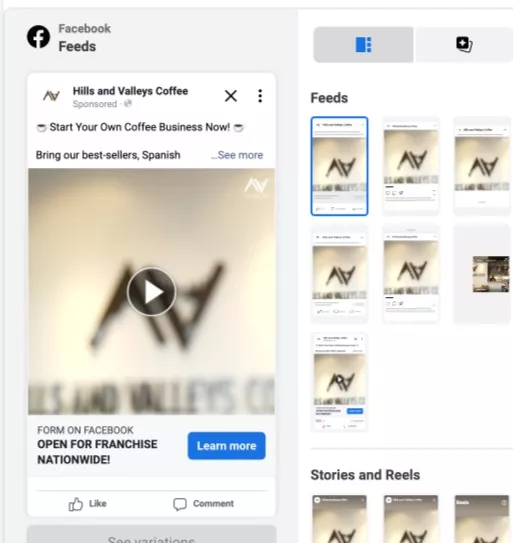
So, for the three Ad Sets, here’s how it looks like:
- 1st Ad Set (MOST NARROW)- 3 interests overlapping
- 2nd Ad Set (MEDIUM) - 2 interests overlapping
- 3rd Ad Set (MOST BROAD) - 1 interest
You can test which audience will resonate with your customers by targeting these three audience groups with different interest intersections.
Add more budget to the adset where ads are highly performing. Or distribute it to adsets with significant ROI regarding clicks and leads/inquiries.
6. Claim Google Business
Google My Business is a free Google service that lets you create a business listing online.
Once your account and data have been verified by Google, you’ll see your business displayed on Google Maps. And when your coffee customers start looking for your brand on Google, they’ll start seeing your map location, an image, and all the general business information you input.
Follow this procedure to create or claim your GMB Listing. You’ll be asked to fill out many fields related to your business's specifics. In the Philippines, we have to do the traditional way of entering a code via snail mail to verify your account entirely.
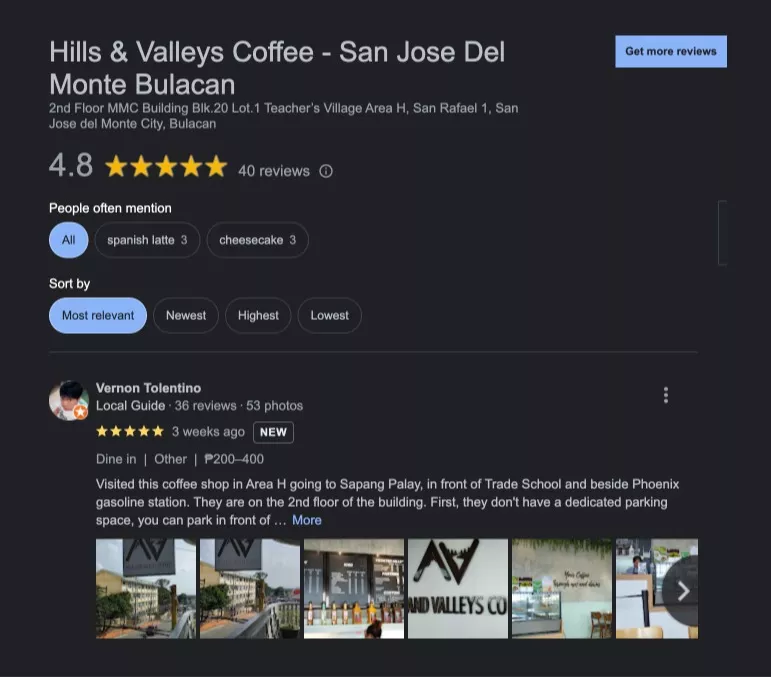
Ensure you include accurate information about your business - NAP, which stands for Name, Address, and Phone Number.
Take photos of each area of your store and upload them to GMB. The higher the resolution of your images, the better.
And to rank your GMB better on local map packs, you must ask for reviews from your potential customers. The more reviews you have, the more chances you can climb the map pack rankings faster.
One of the best ways to provide feedback on your store and products is to incentivize them with freebies (or discounted products).
Many potential customers search on Google when they’re looking for a cafe near their place (or when they visit a particular tourist spot - e.g., Tagaytay).
And when your Google My Business ranks for keywords like “coffee shop in Tagaytay,” you’re likely to increase visibility for those customers and get more foot traffic to your store.
This leads to our next coffee shop promotional strategy: creating your website.
7. Create Your Business Website
Having a business website is a minimum requirement in marketing a coffee shop. It displays your store address, store hours, and contact information, and you can also use it to promote your coffee shop.
SEO, or search engine optimization, is one of the digital marketing disciplines that aims to optimize the website to rank on its target keyword on Google’s search engine results pages (SERPs).
You want to rank for “coffee shop in Baguio.” You optimize your homepage for the key phrase, “coffee shop in Baguio,” so you’ll have chances to rank for it.
And through online rankings, you get visitors who’ll be curious about coffee shops and could add up to foot traffic for your local cafe.
Here are a few tips when doing SEO for your local cafe:
- Include your target keyword in the page URL (/coffee-shop-in-baguio/), or it is your homepage. You simply add the keyword in your meta title.
- Add the keyword in the meta description, H1, H2s, and first sentence.
- Publish an “about”, “history”, and contact pages.
- Include all relevant information about your cafe, including store hours, address, menu, and Google Maps.
The goal is to make it easy for potential customers to visit your store by providing all relevant information.
Pro Tip: Include a Meta Chat Plugin connected to your Facebook page. So when someone wants to ask a question about your cafe, you’ll receive it straight using your Meta Page.
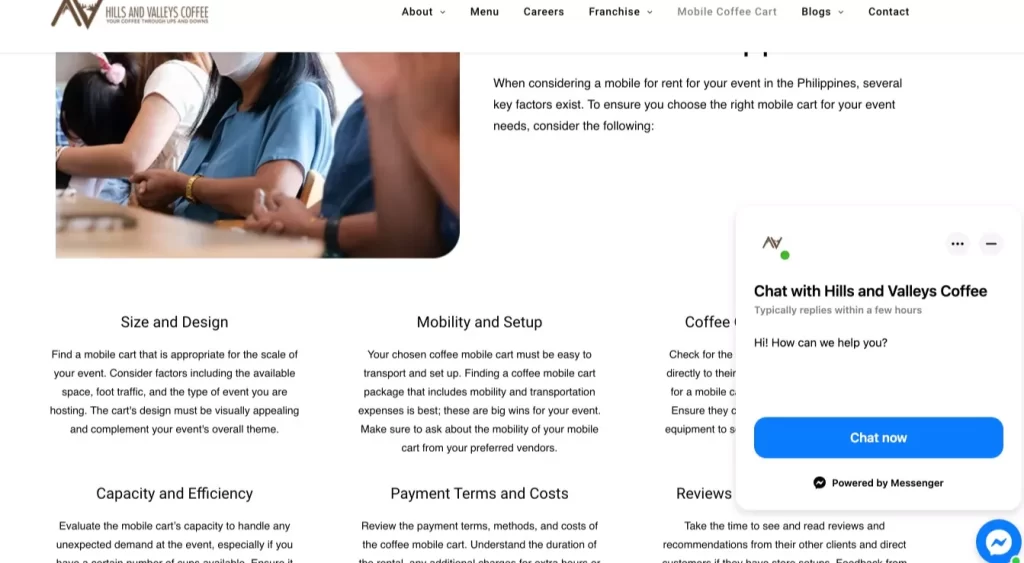
8. Create a Loyalty Program
One effective method to retain your customers is to create a loyalty program.
A loyalty program helps you to entice people to purchase recurring transactions every week (if not every day) and get the most benefit from your products by offering a more affordable option.
At Hills & Valleys Cafe, our loyalty cards allow customers freebies on their 3rd, 5th, 7th, and 10th transactions. At the 10th transaction, let’s say they’ll get a free coffee of any size.
More tips on creating a loyalty program:
- Determine your best-selling coffee/drinks and include it as part of your loyalty program, i.e., they get this free best-selling drink at the 10th purchase.
- Design your loyalty program at its best. Make it glossy and easy to carry in customers’ pockets.
- Sign every loyalty card as proof of purchase. Train your baristas to do so.
9. New Product Launches
New product launches are a great way to promote your coffee shop. Not only do you encourage customers to buy new products, but you can also use them to support other products on your menu.
You can integrate it into other coffee shop promotional strategies like seasonal or holiday campaigns.
When launching new products, the good part is you add excitement to your customers, giving them more reasons to buy more and repeatedly from your local cafe.
Pro Tip: Think of a new beverage (drink/food) every 3 to 4 months. And aim to launch them to attract new customers and retain loyal ones.
10. Exclusive Of Stores For Events
One of the uncommon promotional strategies for local cafes and restaurants is allowing customers to use the store venue exclusively.
This means they’ll pay for 2 to 4 hours and use it for business meetings or personal gatherings like bridal showers, presentations, seminars, pre-nuptial celebrations, or a simple hangout with friends.
Think of how you can create an exclusive event program that may or may not include consumables of your products.
For example, at Php10,000, your client can use the store for 2 hours, with Php10,000 worth of drinks and food.
So, based on your target audience and location, how can you incorporate an exclusive store for events.?
11. Grow Social Media Profiles
63% of consumers use social media to find new restaurants or explore new menu items.
This paves an important truth that every cafe or restaurant should start and grow their social media profiles.
Not only targeting likes and followers but aiming for the main goal - driving foot traffic to your local cafe.
Actionable tips to grow your social media following:
- Identify your target audience.
- Base your messaging on your audience groups so you can empathize and resonate your content with them.
- Set a content calendar to schedule every content asset on your social media profiles.
- Create content that targets your target customer's pain points, challenges, and needs.
- You can use ChatGPT to generate content ideas and even write captions for your social media profiles. Be more specific with your prompts.
- Use Meta Advertising to get direct conversions - messages or inquiries to your website.
- Collaborate or tag other local business partners and cross-promote their products or services.
- Post user-generated content (images of your customers in your store, sipping your coffee, and other photos snapped by your customers).
Build Your Branding For Your Local Cafe
You’ve seen how to promote your coffee shop using 11 different marketing strategies, done online and face-to-face setups.
Assess your resources and determine which promotional strategy best suits your needs, context, and preferences.
List of Raw Materials For Coffee Shop
A list of raw materials for a coffee shop makes your baristas familiar with what they need to brew a perfect espresso.
Whether you want to open a cafe or search for how much each raw material costs?
You need two lists: raw materials to create a coffee beverage and coffee supplies.
Let’s dive in.
List of Raw Materials For Coffee Beverages
- Coffee Beans - choose Arabica or Robusta, or your signature blend for coffee beans. These are seeds of the coffee plant, roasted and used in espresso machines to produce a rich and aromatic espresso.
- Milk - is used for hot and cold coffee beverages as an added sweetness to the taste.
- Sweetened Milk - a sweetener that enhances the taste of a specific coffee beverage (e.g., Spanish Latte).
- Heavy Cream is a thick dairy product for whipped cream, breve, and frapped-style beverages.
- Whipped Cream - is used heavily for frapped types of beverages, like the one you see in Starbucks Frappuccino drinks.
- Syrups - concentrated solutions of sugar in water used to sweeten drinks and desserts, come in many fruit and traditional flavors, i.e., caramel, white mocha, French vanilla, and hazelnut.
- Sauce is a liquid or semi-liquid condiment that adds flavor or moisture to coffee and non-coffee beverages.
- Chocolate Bar - solid blocks of chocolate ranging from sweet to bitter, best for mocha, chocolate coffee, and non-coffee drinks.
- Matcha Powder - a finely ground powder made from grown and processed green tea leaves, primarily used for matcha drinks.
- Frappees Powder - a flavored powdered mix with a creamy and frothy texture used for frappe-style beverages.
- Sugar - is needed to sweeten drinks.
- Brown Sugar - distinctive brown color, suitable for specific beverages.
- Water - essential for any type of drink (coffee and non-coffee beverages)
- Other sweeteners - you can create your blend of sweeteners to add taste to your beverages.
- Creamer - dairy or non-dairy additives to lighten and enrich the flavor of coffee. You can put it in a container where customers can freely pick it to sweeten their coffee.
List of Coffee Shop Supplies
Here is a list of coffee shop supplies you need to prepare beverages for customers.
- Disposable Cups - single-use containers made of plastic designed to hold iced beverages.
- Paper Hot Cups and Lids - insulated paper caps to hold hot beverages, accompanied by lids to prevent spills.
- Cup Sleeves - protective layers that fit around a cult to provide insulation and protect hands from hot contents.
- Coffee to Go Boxes - large, insulated containers designed to hold multiple servings of coffee for takeaway or delivery.
- Cake Boxes - cardboard or paper containers designed to transport cakes and pastries.
- Disposable Bags - single-use bags, often made of plastic, used for carrying items.
- Paper Bags - eco-friendly bags made of paper, often used for carrying baked goods or small purchases.
- Straws and Stirrers - tools used to sip cold beverages or mix additives like sugar and creamer into coffee.
- Napkins - thin paper or cloth squares used to wipe the mouth or hands and protect clothing.
- Coffee Filters - porous paper or metal devices used to strain coffee grounds from the brewed liquid.
- Cleaning Supplies - products like brushes and cloths to maintain cleanliness in a coffee shop setting.
Why Create Your Lists of Raw Materials and Supplies?
One best practice in starting a coffee shop business is keeping everything organized. If you can arrange items into proper places, either raw materials in one place or sets of tables for good seating, you’ll have smoother and better operations and customer experience.

Creating your lists of raw materials and supplies offers various benefits as a cafe owner or barista. Let me give you some compelling reasons to create lists.
Proper Inventory Management
When you know precisely all the raw materials and supplies to create a single beverage, you can determine the exact quantity you need and purchase every week or month.
Thus, it helps you to stay in stock due to the unavailability of certain raw materials. This may significantly cause sales, as you cannot keep the demand for some of your drinks.
By creating lists of raw materials and coffee shops, you can perform better inventory management, which has a massive effect on growing your monthly sales.
Waste Reduction
Another primary reason you should have your lists of raw materials is to save time in your store. This means you are now in control of the amount and quality of each beverage and can be very detailed as to the exact quantity of raw materials to be used.
Instead of spending too much raw materials in one drink, you can train your baristas to specify the amount used while sustaining the quality of drinks.
Without any list or inventory management, you allow baristas to waste some raw materials, which can significantly add to the cost of goods sold in your coffee shop.
Preparation for Expansion
When you organize lists, you are preparing your startup cafe to brand out to other locations. This means that you establish systems to ensure every store will have the same quality (or even higher) and avoid any technical and operational issues due to inconsistent execution of beverage preparation.
If you’re an aspiring cafe owner, you should be looking forward to this and must be adept at growing your cafe business.
Faster Coffee Preparation
When your baristas have a list of raw materials that can be included in your cafe manual, you can have confidence in the quality of each coffee they create for customers.
Given that each of them follow the exact step-by-step guide with lists for a quantity of raw materials, you can ensure the same coffee experience for all your customers.
Customer experience is an essential factor in running and growing coffee shop operations. It will retain your loyal coffee lovers and help spread positive word-of-mouth about the taste and quality of coffee your baristas prepare for them.
Exceptional Customer Experience
You don’t want your baristas to be confused with beverage operations, let alone consume time in thinking if they still have stocks of raw materials for every beverage. You want them to be comfortable and confident whenever they face their customers.
By having lists, you can create an exceptional customer experience where every barista and staff are focused on helping your customers get what they want.
Why Coffee Shop is a Good Business in the Philippines
Starting a coffee shop business is not a walk in the park. It requires grit, creativity, and resourcefulness to succeed in the food and beverage industry.
The Philippines is a country of coffee enthusiasts, with nine out of 10 Filipino households consuming coffee regularly. The latest Philippine coffee statistics reveal that in 2020 alone, about 3.3 million 60-kilogram bags were used. It has grown up to date. For further reading, you can check out this guide on Philippine coffee consumption trends.
If you’re not convinced yet, here are the primary reasons why a coffee shop is a good business and some major challenges you’ll face when you venture into this type of business.
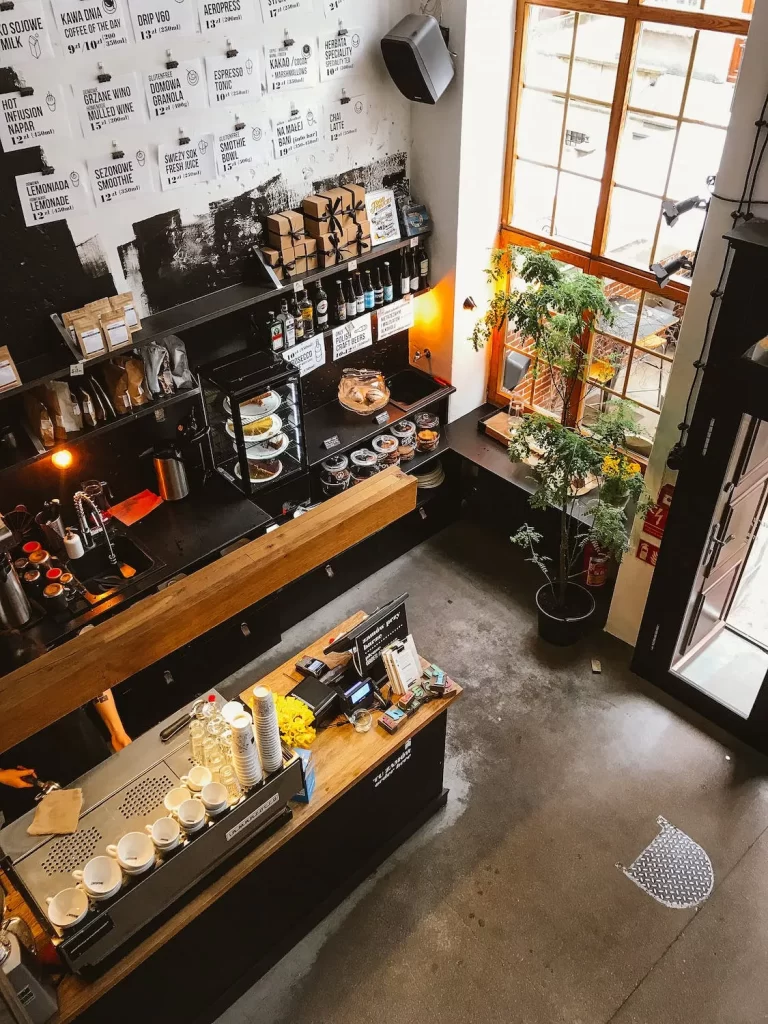
Why Coffee Shop is a Good Business in the Philippines
Growing Specialty Coffee Market
The demand for specialty coffee is on the rise in the Philippines. Consumers are becoming more discerning about the quality and origin of their coffee beans when they’re at the cafe counter.
Today's trend is offering unique and high-quality specialty coffees from startup brands or coffee franchise in the Philippines. A coffee shop that can tap into this new desire and behavior of consumers has the highest potential to attract coffee connoisseurs.
With the specialty coffee market, cafe owners and baristas in the Philippines have begun to create new beverages and mix and match ingredients to cater to the increasing taste changes of their target audience.
For young people, flavored frappes have been a go-to beverage, while for health-conscious consumers, matcha lattes and fruit juices - non-coffee drinks are added to the cafe menu.
Strong Coffee Culture
The Philippines has a rich coffee culture with a growing popularity among coffee enthusiasts. Many Filipinos gather in coffee shops to socialize, work, have fun, and enjoy coffee.
The number of coffee shops built in every town and city in the Philippines has grown since the 2020 Global Pandemic. Many cafes have recovered their businesses, as many companies brought their employees back to work in physical offices.
Filipinos' deep desire for better and longer socialization is seen in long lines waiting for their cups at the counter. A lengthier stay in cafes is also encouraged by cafe owners and baristas, as they’ve seen many people seeking longer intimate moments with friends and families.
Rising Disposable Income
The country’s economy has been steadily growing, leading to an increase in disposable income among Filipinos. With many freelancing jobs and outsourcing opportunities in the country, professionals acquire additional income streams, translating to more spending power to indulge in coffee shop experiences.
They are making the coffee industry a lucrative business opportunity to pursue. In earlier years, you’ll only see corporate professionals conduct meetings and intimate gatherings in coffee shops. Students and young people gather inside cafes, taking Instagrammable pictures for their social media profiles.
This behavior change is a positive signal to invest in the coffee shop business in the Philippines. Foreign brands have recently brought their international taste to the Philippine coffee scene.
Affordable Equipment
The rise of specialty coffee in the Philippines led many coffee suppliers to complement the country's overarching coffee ecosystem. Suppliers for coffee syrups, sauces, cups, and espresso machines in the Philippines, make it easy for budding entrepreneurs to put their cafe brand from scratch.
Affordability, reliability, superior quality, and convenience are key factors cafe owners look for in every coffee shop supplier. While many fly-by-night cafe suppliers exist, you can find a few reliable options locally in the Philippines, including Blend N Sips.
Diverse Menu Options
The coffee shop business in the Philippines has expanded its offerings beyond traditional coffee beverages. Most cafes you’ll visit provide food items, including pastries, sandwiches, and snacks, catering to diverse customer preferences and needs.
This expanded menu allows coffee shops to attract a broader customer, improve customer retention, and ultimately, increase revenue streams.
There are Philippine cafes that offer non-coffee beverages to add up to the increasing demand for tea-based products and frappes, which Starbucks Coffee initially introduced.
By having diverse menu options, you’ll attract more tourists to every go-to city and location in the Philippines - making cafes an additional tourist spot for foreign nationals.
Rising Demand for Co-Working Spaces
The rise of freelancers, entrepreneurs, and remote workers has filled the demand for co-working spaces. This led to starting entrepreneurs to put up their cafes, making them a popular choice for individuals seeking a productive and inspiring environment outside their traditional office settings.
Their buying capability and need to offer a great opportunity for anyone to put a coffee cart, store type, or even a fit-out brand beside co-working spaces or inside corporate buildings. Capitalizing on this trend can lead to a steady stream of customers throughout the day.
Social Media Influence
Filipinos are one of the most tech-savvy people in the world. Their activeness on social media platforms, like Tiktok, often serves as attractive backdrops for Instagram-worthy photos.
Creating visually-appealing designs and Instagrammable spaces for cafes can generate free online marketing through user-generated content, increasing brand exposure and potential new customers.
Social media marketing campaigns can help build a solid brand for startup cafes and, ultimately, any cafe supplier looking to generate more awareness for their brand.
On top of it, you can see other digital marketing channels, like search engine optimization and pay-per-click advertising, to be go-to marketing strategies for starting cafe owners. They can penetrate the local coffee industry with an affordable budget, maintaining their overhead costs at a minimum.
Tourist Hotspots
The Philippines is a popular tourist destination, attracting millions of yearly visitors. This alone can help coffee shops cater to many customers, including domestic and international tourists.
Offering them a place to relax, recharge, and experience a local coffee culture is a unique experience most tourists would love to return to.
If you’re an aspiring coffee business owner, placing your cafe in tourist hotspots is a great way to guarantee foot traffic from regular tourists to hotels, beaches, and other popular destinations in your target city or location.
Community Engagement
Coffee shops can become community hubs, fostering a sense of belonging and community engagement. By hosting events, seminars, workshops, gatherings, and even intimate occasions such as weddings, coffee shop owners can create a sense of loyalty among their customers.
Community engagement can establish the coffee business as an integral part of the local community, which builds a strong coffee culture for the nation.
Invest In A Thriving Business
When investing in a business, one big factor is the profitability and industry you’ll be venturing into. It must be thriving where customer demand is going in the right direction.
Fortunately, the coffee business is one of those thriving industries you can consider as an aspiring entrepreneur. By having a good set of coffee suppliers, a proper location, a targeted marketing campaign, and a strategic business plan, you can create a coffee business that can grow for years.
Why Coffee Shop is a Good Business in the Philippines FAQs
Why is it good to have a coffee shop business?
Having a coffee shop business in your community is beneficial for various reasons. It creates local jobs, stimulates the local economy by supporting other businesses, and promotes a diverse economic landscape. Additionally, sourcing products and services locally can have a positive environmental impact. Overall, small coffee shops contribute significantly to the growth and sustainability of the community.
Is coffee a good business?
Coffee can be a profitable business venture, with most coffee shops becoming profitable within a few years. Success depends on food production costs and key performance indicators (KPIs). By year five, coffee shops can expect their sales to double. Carefully considering budget contingency funds, startup costs, and initial operational expenses is crucial for success in the coffee business.
Why is coffee shop a good business in the Philippines?
Coffee shop business in the Philippines is a lucrative venture due to its high demand and booming industry. With over 2,752 café and coffee shops in the country (2020 data from PSA), it's evident that we are a nation of coffee enthusiasts. Coffee consumption is a common habit among nine out of 10 Filipino households, making it a great market for aspiring entrepreneurs.
Why do people love coffee shops?
People love coffee shops because they provide the perfect cup of coffee that energizes them for the day. Additionally, coffee is considered a part of a balanced diet, which makes it even more appealing. So, coffee at a coffee shop helps individuals feel refreshed and satisfied.
63 Coffee Statistics in the Philippines You Need to Know in 2025
Coffee statistics in the Philippines have revolutionized the beverage industry much like fintech did to the financial sector, morphing it into a multi-billion peso stronghold that experiences incredible year-on-year growth.
Projections indicate that the coffee sector, which includes the cultivation, production, and coffee shop businesses, may surpass PHP 200 billion by the end of this decade.
How big is the coffee market in the Philippines?
As of 2023, the Philippine coffee market is valued at USD 1.62 billion, with a projected CAGR of 5.9% from 2023 to 2028.
What percentage of Filipinos drink coffee?
About 90% of Filipino adults consume coffee daily. Coffee drinking is embedded in Filipino culture, often enjoyed during breakfast or social gatherings.
What type of coffee do Filipinos consume the most?
Instant coffee remains the most popular type, capturing nearly 90% of market share. Convenience and affordability are key reasons behind its widespread use.
How much coffee does the Philippines consume annually?
The Philippines consumes more than 100,000 metric tons of coffee annually. Local production cannot meet demand, so over 70% of coffee is imported.
Is the Philippines a coffee-producing country?
Yes. The Philippines produces four varieties of coffee: Arabica, Robusta, Excelsa, and Liberica. Despite this, local production accounts for only 30% of national consumption.
What is the main challenge in the Philippine coffee industry?
The biggest challenge is low productivity on farms. Factors include aging farmers, limited access to modern equipment, and strong foreign brand competition.
How do MSMEs perform in the coffee manufacturing sector?
MSMEs in coffee manufacturing reported performance better than target in return on assets (ROA), profit margin, sales growth, and market share. However, they operate under high competitive pressure.
What factors affect coffee MSME performance?
Based on Porter’s Five Forces framework, key factors are:
- Competitive rivalry: Very high
- Bargaining power of suppliers and buyers: High
- Threat of new entrants and substitutes: High
These forces significantly affect MSMEs’ financial performance.
What is the forecast for the coffee industry in the Philippines?
The government aims to achieve 100% self-sufficiency by 2040. Current efforts focus on improving local production through training, mechanization, and investment partnerships.
Are there opportunities in the Philippine coffee market?
Yes. Growth areas include:
- Specialty coffee shops
- Ready-to-drink (RTD) products
- Sustainable sourcing
- Local bean promotion
Rising coffee consumption and urbanization create more room for innovation and entrepreneurship.
Coffee Industry Philippines Statistics
The Philippines is the 14th largest coffee producer in the world, contributing significantly to the global coffee industry. (Source: The Philippine Coffee Industry Roadmap 2021-2025)
The coffee industry in the Philippines is expected to grow at a CAGR of 3.5% from 2021 to 2025. (Source: The Philippine Coffee Industry Roadmap 2021-2025)
The Philippines coffee industry is dominated by four primary species: Arabica, Robusta, Excelsa, and Liberica. (Source: The Philippine Coffee Industry Roadmap 2017-2022)
Robusta accounts for 69% of the total coffee production in the country. (Source: The Philippine Coffee Industry Roadmap 2021-2025)
The Philippine coffee industry predominantly comprises smallholder farmers, with 95% of farms measuring less than 5 hectares. (Source: The Philippine Coffee Industry Roadmap 2017-2022)
The country's coffee industry faces a significant gap between production and consumption, with a deficit of 37,000 MT in 2017. (Source: The Philippine Coffee Industry Roadmap 2017-2022)
The Philippines government has developed the Philippine Coffee Industry Roadmap 2017-2022 to boost the sector's growth. (Source: The Philippine Coffee Industry Roadmap 2017-2022)
The coffee industry in the Philippines is characterized by very high competitive rivalry. (Source: Industry Characteristics and Performance of Philippine Coffee Manufacturing Firms: MSMEs Perspective)
The threat of potential entrants in the Philippine coffee industry is high, indicating that new companies can quickly enter the market. (Source: Industry Characteristics and Performance of Philippine Coffee Manufacturing Firms: MSMEs Perspective)
For the first quarter of 2023, the production of coffee (green coffee beans) in the Philippines was estimated at 9.42 thousand metric tons, marking a 1.3 percent increase from the same quarter of 2022. (Source: Philippine Statistics Authority)
Robusta remains the country's most-produced type of coffee, accounting for 73.5 percent of the total production during the first quarter of 2023. (Source: Philippine Statistics Authority)
SOCCSKSARGEN is the highest producer of coffee in the Philippines, contributing 33.4 percent of the country’s total coffee production for the first quarter of 2023. (Source: Philippine Statistics Authority)
Revenue in the Coffee market in the Philippines amounts to US$2.33bn in 2023. (Source: Statista Market Forecast)
The Coffee market in the Philippines is expected to grow annually by 8.22% (CAGR 2023-2028). (Source: Statista Market Forecast)
The volume in the Coffee market is expected to amount to 183.10m kg by 2028. (Source: Statista Market Forecast)
The average volume per person in the Coffee market is expected to amount to 1.25kg in 2023. (Source: Statista Market Forecast)
The revenue in the coffee segment is projected to reach US$4,439m in 2023. (Source: Statista)
The market is expected to grow annually by 12.1% (CAGR 2023-2025). (Source: Statista)
In relation to total population figures, per-person revenues of US$40.63 will be generated in 2023. (Source: Statista)
The average per capita consumption stands at 2.4 kg in 2023. (Source: Statista)
Arabica coffee, which shared 24.2% of total production, increased by 2.0%. [Source: Philippine Statistics Authority]
Production of Excelsa coffee, which accounted for 5.8% of the total output, rose by 1.1%. [Source: Philippine Statistics Authority]
However, Liberica coffee, which contributed 0.3% to the total production, declined by 1.6%. [Source: Philippine Statistics Authority]
The Philippines’ instant coffee market is estimated to grow at a CAGR of 12.29% to reach a market size of US$4,422.197 million in 2028 from US$1,964.402 million in 2021. [Source: Knowledge Sourcing]
The prime factor predicted to drive the growth of the Philippine instant coffee market is the growing trend of coffee consumption, in addition to the increasing production initiatives taken by the government in the country. [Source: Knowledge Sourcing]
The offline segment dominates the Philippines' instant coffee market, owing to greater storage space and a wider selection among many products contributing to the demand for retail growth under the offline segment. [Source: Knowledge Sourcing]
Coffee Consumption Philippines Statistics
Filipinos consume an average of 2.4 cups of coffee per day. (Source: The Philippine Coffee Industry Roadmap 2017-2022)
The annual per capita consumption of coffee in the Philippines is estimated at 2.4 kg. (Source: The Philippine Coffee Industry Roadmap 2017-2022)
The total coffee consumption in the Philippines is projected to reach 166,000 MT by 2022. (Source: The Philippine Coffee Industry Roadmap 2017-2022)
The consumption of soluble coffee in the Philippines is expected to grow at a CAGR of 5.5% from 2021 to 2025. (Source: The Philippine Coffee Industry Roadmap 2021-2025)
The consumption of green coffee in the Philippines is expected to grow at a CAGR of 2.7% from 2021 to 2025. (Source: The Philippine Coffee Industry Roadmap 2021-2025)
The Philippines' instant coffee market is projected to grow at a CAGR of 12.29% to reach a market size of US$4,422.197 million in 2028 from US$1,964.402 million in 2021. (Source: Philippines Instant Coffee Market Size: Industry Report, 2023 – 2028)
Filipinos are projected to spend an average of $44 per person on instant coffee in 2022. (Source: Coffee Affection)
Filipinos are expected to consume 3.78 kilograms of coffee per person by 2025. (Source: Coffee Affection)
Before the Covid pandemic, Filipinos consumed 3.4 kilograms of coffee per person per annum. (Source: Coffee Affection)
The Philippines is the second-largest consumer of coffee in Asia. (Source: Coffee Affection)
90% of households in the Philippines have coffee in their cupboards. (Source: Coffee Affection)
93% of households buy some coffee every week. (Source: Coffee Affection)
Filipinos are now considered heavy coffee drinkers. (Source: Coffee Affection)
Coffee Shop Philippines Statistics
The number of coffee shops in the Philippines has been growing steadily, with a 3% increase in outlets in 2017. (Source: The Philippine Coffee Industry Roadmap 2017-2022)
The coffee shop industry in the Philippines is dominated by international chains, with local chains and independent outlets also making a significant contribution. (Source: The Philippine Coffee Industry Roadmap 2017-2022)
The coffee shop industry in the Philippines is expected to grow at a CAGR of 7.1% from 2021 to 2025. (Source: The Philippine Coffee Industry Roadmap 2021-2025)
The average spend per visit to a coffee shop in the Philippines is PHP 300. (Source: The Philippine Coffee Industry Roadmap 2017-2022)
The coffee shop industry in the Philippines is characterized by high competitive rivalry, with a large number of international and local players. (Source: Industry Characteristics and Performance of Philippine Coffee Manufacturing Firms: MSMEs Perspective)
The coffee shop industry in the Philippines has seen a significant increase in the number of local coffee shops, contributing to the industry's overall growth. (Source: Coffee Shops in the Philippines: Statistics)
Coffee retail brands such as UCC, Starbucks, and Coffee Bean & Tea Leaf have established a strong presence nationwide, providing further incentives for the industry to develop. (Source: Philippines Instant Coffee Market Size: Industry Report, 2023 – 2028)
Starbucks is, by far, the biggest coffee shop chain in the Philippines. (Source: Coffee Affection)
The average cost of a cup of coffee in a coffee shop in the Philippines is $3.02. (Source: Coffee Affection)
The Philippines has seen a significant increase in coffee shops, with a growth rate of 12.7% in 2021. This growth is attributed to the increasing coffee culture in the country and the expansion of international coffee chains like Starbucks and The Coffee Bean & Tea Leaf. Coffee Shops in the Philippines Statistics
Coffee Drinkers Philippines Statistics
Approximately 90% of Filipino adults consume coffee regularly. (Source: The Philippine Coffee Industry Roadmap)
The average age of coffee drinkers in the Philippines is 24-35 years old. (Source: The Philippine Coffee Industry Roadmap 2017-2022)
Approximately 60% of coffee drinkers in the Philippines prefer instant coffee due to its convenience and affordability. (Source: The Philippine Coffee Industry Roadmap 2017-2022)
About 40% of coffee drinkers in the Philippines prefer brewed or specialty coffee. (Source: The Philippine Coffee Industry Roadmap 2017-2022)
The preference for specialty coffee among Filipino coffee drinkers is growing, with a 10% increase in consumption in 2017. (Source: The Philippine Coffee Industry Roadmap 2017-2022)
The growing trend of coffee consumption in the Philippines is a significant driver for the growth of the instant coffee market. (Source: Philippines Instant Coffee Market Size: Industry Report, 2023 – 2028)
The Department of Agriculture (DA) announced a collaboration with Nestlé Philippines in October 2022 to scale up the coffee business, focusing on expanding local production and enhancing the country's sufficiency level, which is presently at 15%. (Source: Philippines Instant Coffee Market Size: Industry Report, 2023 – 2028)
According to the Philippine Council for Agriculture and Fisheries, Robusta is the most farmed coffee variety in the nation, accounting for 76.5% of total output in 2020. (Source: Philippines Instant Coffee Market Size: Industry Report, 2023 – 2028)
Nestle Philippines, Inc. is the largest local manufacturer of soluble coffee, accounting for 80% of the instant coffee market. (Source: Philippines Instant Coffee Market Size: Industry Report, 2023 – 2028)
90% of households in the Philippines have coffee in their cupboards. (Source: Coffee Affection)
80% of Filipino adults drink an average of 2.5 cups of coffee daily. (Source: Coffee Affection)
93% of households in the Philippines buy some coffee every week. (Source: Coffee Affection)
Filipinos are now considered heavy coffee drinkers. (Source: Coffee Affection)
How to Venture Into This Coffee Shop Industry
Whether you're already in the coffee business or looking to venture into this dynamic industry, understanding the comprehensive coffee statistics in the Philippines is crucial. The coffee industry here shows no signs of slowing down, presenting vast opportunities with billions of pesos invested annually and a significant percentage of the population indulging in coffee daily. You certainly want your business to stay caught up in this thriving landscape.
When people look for their next coffee shop visit or a brand to bring home, they often turn to search engines for information. As the potential franchise owner of a coffee shop, you should ensure your business is among the first to show up when customers start their online search.
Hills and Valleys Coffee has the expertise to help your coffee shop business gain visibility and thrive in the Philippines. Our franchise offers a turnkey solution covering everything from location selection, setup, and marketing, ensuring your business is ready to brew success.
To learn more about how Hills and Valleys Coffee Co. can help you become a part of the flourishing coffee industry in the Philippines, check out our coffee shop franchise. Or reach out to us today for a detailed discussion. Let's brew success together in the land of coffee lovers.Coffee Industry Statistics Philippines 2023: Discover key trends, growth projections, and consumption patterns in the Filipino coffee market.
How to Compute Expected Daily Sales of Coffee Shop in the Philippines
Knowing your numbers is one key to growing your cafe business. Whether you’re an aspiring coffee entrepreneur or an established one, you should know the expected daily sales of your coffee shop in the Philippines.
Expected Daily Sales of Coffee Shop in the Philippines
Daily sales are among the first numbers to track when managing your coffee shop. By knowing how much cash and non-cash transactions go into your store from any purchase transaction, you’ll get to know if the cafe business is thriving or not.
Daily sales knowledge allows you to be more flexible and adaptive to every change happening in your local market.
For instance, if you know that your weekends must have an average daily sales of Php 15,000 to Php 25,000, and you find out four consecutive weekends to be lower than your expected daily sales, you could now make adjustments either with the quality of coffee you brew (to get returning customers), or promote even better to acquire new coffee lovers.
You can’t simply ignore knowing your expected daily sales, as this can help guide your rational decision in running and sustaining your cafe.
9 Easy Steps to Compute for Daily Sales of Coffee Shop
Now, let’s proceed to how you can compute the daily sales of coffee shops.
1. Record Every Sale
You first need to have a recording of every transaction in your coffee store.
The most convenient and effective way is to have a point of sale (POS) system so your baristas can easily input transactions on a tablet or any compatible device.
Tip: We use Utak POS in our coffee shop in Bulacan. It is an affordable POS in the Philippines (we don’t get commissions for recommending them).
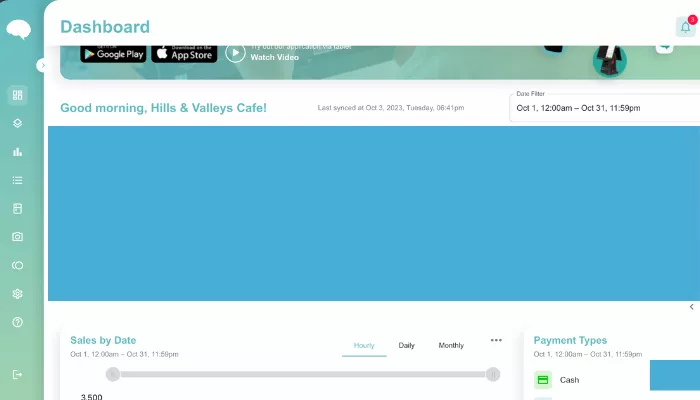
There are also alternatives to POS, such as a cash register or manual recording system to track every sale made during the day.
See what fits your cafe, but I highly recommend investing in a POS to efficiently track numbers and monitor daily sales when you’re not around the cafe.
2. Categorize Sales (optional but helpful)
This step is optional, and you may skip this. But if you want to be more detailed about the sales numbers, you can break down sales into categories such as beverages, pastries, and merchandise.
This way, you can determine which products are popular (best-selling for the month) and profitable.
3. Tally Up Total Sales
To get the total sales, you sum up the total amount from all sales transactions. This includes all transactions from every product you sell within the day. This will give you the gross sales for the day.
4. Deduct Returns/Refunds
Check if there were any returns or refunds during the day. If you have delivery apps like FoodPanda and GrabFood, you can check your emails for any refunds within the day.
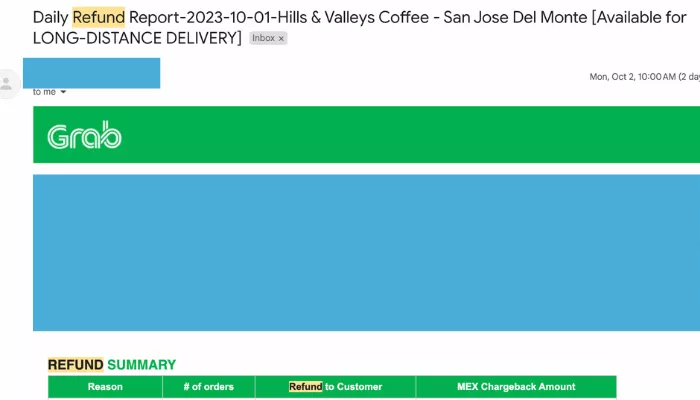
Deduct these amounts from the gross sales to get the net sales.
5. Factor in Discounts and Promotions
If you offer discounts or promotions, account for these reductions in your daily sales.
See the exact amount of each discount and promotion. This would give you the right amount of daily net sales.
6. Include Taxes
Cross-check that taxes are included in your sales amount among your POS and cash registers.
For the most part, taxes are shown separately in receipts, so adding them can quickly get the total sales.
7. Review Cash and Non-Cash Transactions
Review the total for each type if you accept multiple payment methods (e.g., cash, bank accounts like BPI, credit card, Gcash). This ensures your cash drawer matches your recorded cash sales and all electronic transactions have been processed correctly.
8. Double check
It is easy to lose track of the accurate amount. So, it is always an excellent practice to double-check your calculations. If you’re using a POS system, it could give you a daily sales report that looks like this:
You can cross-reference the total amount from POS with manual counts.
9. Document and Store
Ensure you document everything in your cafe business, including your daily sales. You can use spreadsheets, your POS system output reports, or as simple as a physical ledger.
All these documents you can use for accounting and tax purposes, as well as in tracking business performance.
How to Increase Daily Sales Of Your Coffee Shop?
Now that you know how to compute and track your daily sales, applying some of the best practices to increase daily sales is also essential.
Of course, tracking your numbers is good, but more importantly, you should sustain and grow your cafe business even more.
So, here are five ways to increase daily sales of your coffee shop:
1. Find a location with high foot traffic.
This is primarily applicable for starting cafe owners as they have the freedom to choose a store with good traffic of customers.
An established coffee entrepreneur who wants to expand their coffee shop in other locations (either through coffee franchising or a company-owned system) must be looking for a place with high foot traffic.
2. Build your brand.
In Asian countries, particularly in the Philippines, you’ll find coffee shops opening streets in between.
You need to build your brand to differentiate yourself from other local cafes. Ask yourself, “What makes your cafe uniquely different?”.
By focusing on branding with all your marketing efforts, you gain buzz around your local cafe, acquiring new customers and enticing loyal customers to make additional purchases.
Learning and applying fundamentals and tips on promoting your coffee shop is best.
3. Do competitor analysis.
One of the best ways to increase daily sales is to analyze what your competitors are doing.
This is not to mimic every detail of their business activity but to see their strengths and weaknesses, all while spotting opportunities you can take advantage of.
For instance, one audience group we managed to build stronger and deeper relationships with at Hills & Valleys Cafe - teachers. They usually conduct their meetings inside our cafe, allowing us to get recurring bulk orders every week. It also gives you free word-of-mouth marketing within the campus community.
Here are a few insights you can get from doing competitor analysis:
- Gaining traction on a specific platform or marketing channel your competitors aren’t investing in.
- Targeting a group audience (example above), other cafes aren’t strengthening relationships with.
- Promotional activities that have worked for them that you can innovate better to suit your target audience.
Competitor analysis is critical in enhancing your cafe’s branding and ability to capture a larger market share for your business.
4. Maximize the seasonality of products.
One significant insight in managing your coffee shop is understanding the seasonality of your products. You’ve got a primary menu, but there are seasonal beverages that are best to sell during one season.
For instance, you have a Peppermint beverage, suitable for the Christmas season, and another, a Refresher drink, best for the summer season.
You can maximize these seasonal products by creating promotional campaigns like BOGO to entice early sales for the day.
5. Adjust the pricing on offers.
A coffee shop's day-to-day operations may seem routine, but at times, you don’t take the time to pause, reflect, and evaluate what’s happening in your store.
Adjusting the offers' pricing is a good tip to increase expected daily sales. Remember that you should do it cautiously, as your customers might find that you’re taking advantage of them, which could negatively impact sales.
The best thing is to find the right timing when increasing prices for some of your products. For example, when you see inflation happening in some of the ingredients of your products, it is a good, reasonable way to adjust your pricing.
Announce the price adjustment. It is imperative to do it so your customers would know beforehand - a sign of respect for them as your loyal customers.
Key Takeaways
Knowing your numbers is one of a cafe entrepreneur's incredible, essential abilities. By having a good look at your expected daily sales, you can think of any improvement to do for your cafe operations and sustain to expect even more growth.


